#and it’s also at this point inaccurate and outdated even for a theory
Explore tagged Tumblr posts
Text
ACIP has met and recommended the updated mRNA vaccines for everyone 6 months and up. So everyone can relax lol said with kindness as I understand worrying.
Novavax is awaiting FDA approval at this time for their updated vaccine.
The CDC is trying to limit the new COVID booster to only people 75+, pregnant people, and the immunocompromised.
We have two days (as of September 6th, 2023) to let them know this isn't acceptable.
(since there is some lack of visual comprehension in the comments, each picture has the link to the tweet just under the picture)
Under this first tweet is the link directly to the article Laurie put in her tweet and is quoting.

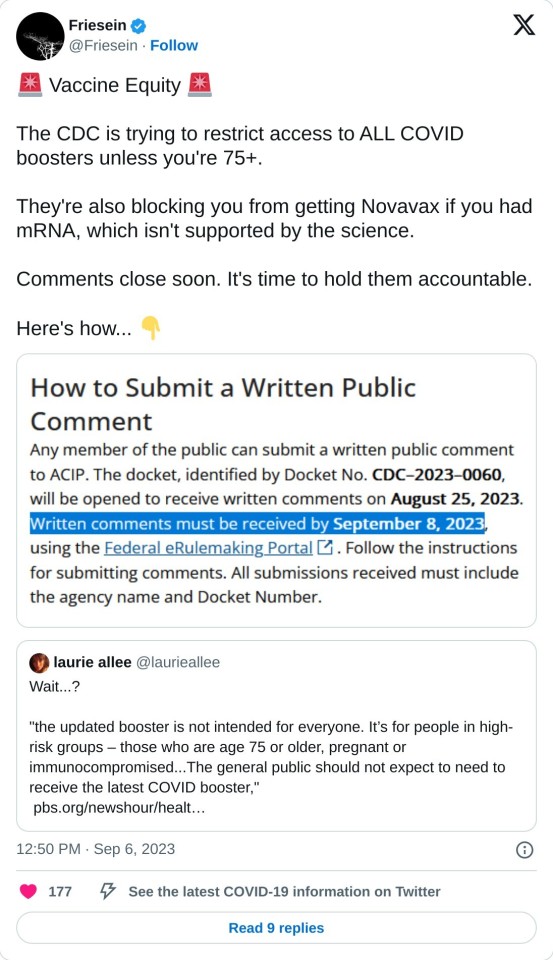
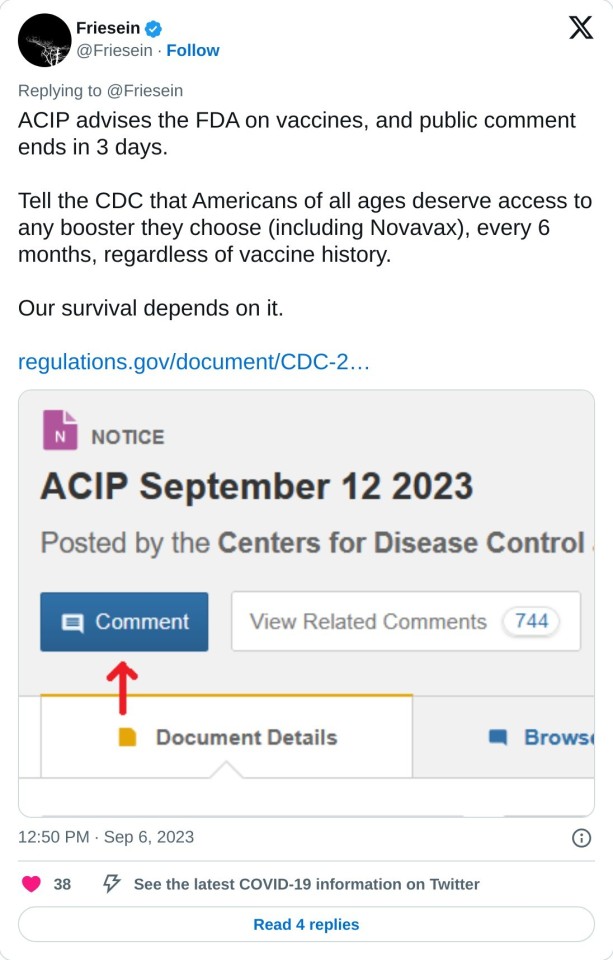
Direct link to the page to submit your comments: click here!
Please, PLEASE fill this out and boost this post!
#I commented again to update on ACIPs recommendation to everyone 6 months and up#again don’t agree with the post lol#and it’s also at this point inaccurate and outdated even for a theory#as ACIP has done their recommendation and it’s for 6 months and up
10K notes
·
View notes
Text
The Mist War (Headcanon essay 1/4) The Land in the Mists
The Mist War is both an event and a place at the same time, one that in theory works like a massive Fractal, but in practice varies in particular ways due to its multiverse nature and much bigger scale. [back to masterpost]
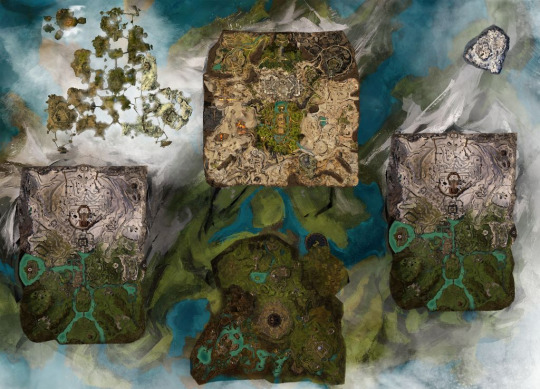
[Note: the map above is indicative of the limited instances of the Mist War witnessed by the cartographer, who hurried out of the Mists before completing it on site, making it likely inaccurate and/or outdated to present times]
Time and scale
For starters, time is on a different and more realistic scale compared to what we experience as players: ticks are not 5 minute intervals but individual hours, skirmishes don't last just 2 hours but a whole day (like the Tyrian in-game day-night cycles do), and resets can happen at any time between a few weeks and almost three months (there are 84 skirmishes between each reset).
The maps are also scaled more "realistically" as well, with the Alpine Borderlands being roughly around 100 x 50 km (62 x 31 miles), Desert Borderland matching the square area of them, and Eternal Battlegrounds being actually much larger than it appears compared to the others. While keeps, towers and camps are more or less proportionate between themselves, the same can't be said for the space between them, as the game always focuses on necessary details for points of interest and cuts out/reduces all that's not necessary or would be boring to traverse. Due to that, everything would be bigger and more complex than what we get to see: roads would go on for kilometers/miles, buildings would have the spaces needed to house and feed at least a handful of Mist Warriors passing through or defending the place, and the transition between environments would be softer and richer in features.
From the perspective of the Tyrians involved in it, the actual warfare is much slower than what we see, with a lot more downtime and preparations, as well as longer travel time between points on the map. The chaotic zerg fights are actually hours-to-weeks long battles and sieges. Rebuilding defenses after conquering an area takes hours at the fastest, instead of an instantaneous magical swirl after a few hammer hits. Getting from one's base to the enemy's garrison could take a few days of travel, especially with necessary rests and supplies to carry, and while warclaws are instrumental to moving faster across the land and can reach any destination in much less time than a Mist Warrior on foot, they're not built for speed and the journey would still take hours. But that would not be fun for us players, so we see/play the sped up version.
[To give a general idea with real life data, depending on the condition and terrain, the travel speed of an army goes between 8 and 30-something km/day, a regular person on foot can do 9-30 km/day, and a rider can reach 30-50 km/day with breaks to let the mount rest and eat. Warclaws are based on big felines, which can reach up to 80km/h on short distances while hunting, but due to their bigger size, armor and rider, they likely can't run that fast even when attacking, let alone maintaining that speed on longer distances. On top of that, even if Mist Warriors were stronger and faster than any person could be, after a long journey they'd still probably need to rest before actually joining the battle.]

The Battlegrounds
The versions of Tyria (worlds or "servers") involved in the Mist War at a given time are not always the same ones, as they drift across and on top of each other through the Mists akin to tectonic plates, metaphysically clashing and causing incommensurable surges of magic that form the lands and fuel the phenomenon itself. There's no way to know how or why it all happened in the first place, but the extremely powerful magic at play there is enough to stabilize such a vast space for weeks and months at a time in its extended fractal-like state, almost immutable cycle after cycle, allowing for its resources to be extracted by each Tyria. Then, when the different versions of Tyria that the magic holds together drift apart and latch onto others (links), it all reverts to its original state (reset), repeating the process once more.
The area where the Mist War takes place is at the exact cross-section between three (sometimes more) different versions of Tyria, with the exact center being where the area known as the Eternal Battlegrounds is located. Each of the three Borderlands is, as their name implies, deeper into the "border" of one of those Tyrias. Most of the fighting happens there and in EV, where the harvestable resources are more easily accessible and plentiful. Neutral areas of scarce interest exist between those lands, but few have reasons to venture there, usually to reach the Obsidian Sanctum or the Armistice Bastion. The Edge of the Mists is a group of islands that floats above the lands, not as rich in resources but still valuable, and it was only recently reachable thanks to the invention of airships. Notably, the Borderlands used to be all similar, just with minor differences between them, but a fairly recent development caused the transformation (or substitution) of one of the normally alpine zones into a desert area, specifically the one located North of EB. Theories suggest that it might be a ripple effect of the first couple of deaths of the Elder Dragons, and the ancient structures in it may push forward the idea that the desert is not a new creation of the Mists, but that it simply re-emerged after a very long time, potentially for the first time since the last Dragonrise.
The never-ending cycle of conquest of those impermanent lands seems like a fool's errand, but the bountiful and ever-replenishing resources and research opportunities aid the warriors' own Tyria, so the war has been continuing with few interruptions for centuries, if not probably much longer. Conquering land not only is necessary to have access to more resources, but one Tyria having more influence over the others at the time of reset statistically seems to increase its following bounty of resources. Despite many attempts at peace having been made in the history recorded by Mist Warriors, greed and necessity won over reason again and again, usually long before the negotiating Tyrias were forcibly separated.
Across the whole land there are various points where the magic of different Tyrias is more powerful and functions as anchor points for each of them, usually following a specific pattern. Mist Warriors make their base of operations around the strongest nexuses, building their main camps in the pre-existing structures surrounding them and placing the asuran waypoints and gates nearby. Most of the other structures on the land are placed on or near smaller anchor points, some still operational and others so ancient they're but ruins. Before the creation of the asuran gates in Lion's Arch in 1324 AE, joining the Mist War required complex rituals known to few, or paying a hefty sum to reroute one of the existing asuran gates in Tyria. Moreover, one needed to be present for when the recruiters would come by, as they toured Tyria as much as possible to keep the numbers in the Mist War from ebbing on too few to be effective. The city of Lion's Arch eventually decided to more or less officially sponsor operations in the Mist War, and now the access is easy and eagerly encouraged by the Mist Warriors, who finally have the numbers to extract all the resources they need once they crush the other Tyrias... who have been doing the same exact thing.

#Mist War#gw2 wvw#wvw#gw2 world vs world#mist warriors#gw2 headcanons#gw2 lore rambling#gw2 mists#the mists#my writing#Skye writes words#pics are all taken from promotional material (gw2's own news) or the wiki
14 notes
·
View notes
Text
Map Problems: Part 1
So, I was looking at the canon map that was released for some of our theories and just... Just no. It hurts me to even look at as it is widely inaccurate and outdated. Some places don’t even exist anymore or they haven’t even been added, so enjoy the rant I am about to go on.

The problem with this map is, however, it makes no logical sense...
First of all; we are told in the game that Beast Yeast is North-East of Dragon’s Valley (DV), no biggie, right? Well, actually, it’s also supposed to be connected. It is NE of DV and resides in/near the Licorice Sea as stated in the game, however, here it is just floating away near Crispia and the Jellyfish Ocean. The Licorice Sea does not exist and therefore, it cannot be in the right position regardless.
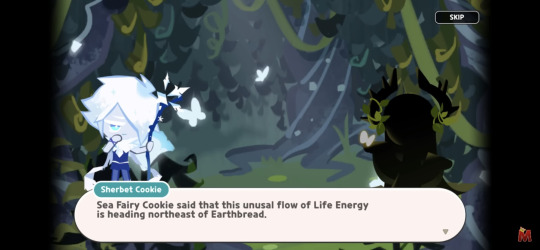

A secondary problem that occurred was that the Giant Icing Ridge is too close to a tropical climate to be considered to be what it is, meaning that, while the Cacao Kingdom would be cold, it would not get to the temperatures to become an icy wasteland where cookies cannot reside without help. It would be a cooler climate, yes, but it wouldn’t be considered an artic or even all year round snowy place.
Realistically, the City of Wizards (CoW) is placed in a weird spot, it is coastal and by the sea, however, it would be much closer to Cacao’s Kingdom (CK) than Hollyberry’s (HBK) as it also holds the Tower of Frozen Waves, which shouldn’t exist anymore by the way. The CoW also has a much cooler climate compared to the tropical, Venice-like weather the HBK has. Not to mention, the CoW is told to be in the mountains, which is not here.
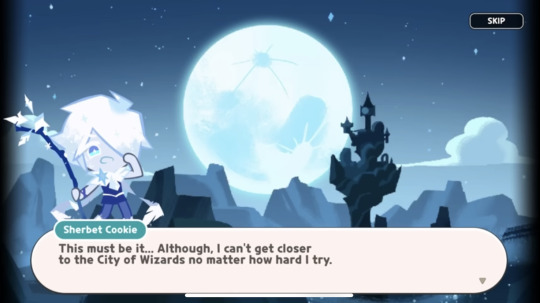
Another possible problem is that the Vanilla Kingdom (VK), is that it is close to the Lake of Truth. Now, this wouldn’t be a problem, but unfortunately it is as the VK is a barren wasteland. After the attack there has been no vegetation growth, there are only dead trees and they are in a severe drought to the point only raisin birds and old raisin residents could survive, the rest of the Vanillians high-tailed it out of there. (Also has anyone even heard of the Blood Jam mountains...?) If they live close to a lake, sure it would take over a hundred years to rehydrate, there would be vegetation growth. However, later in the game, during the Council episodes, it’s shown that the plants have nearly grown back. But that is a problem for another time because I’m not going into the map of tree growth right now. (Picture is to show the drought.)

Even the Sugar Free Road makes no sense as it is shown that Vanilla goes through multiple mountain ranges to reach what is basically “enlightenment”, however, the map never goes through mountains. It is shown they go around through valleys. So this man is either a liar or a fake (/j). It is a possibility but could be the Judgement Ravine, however, this is shown to be nowhere near the mountain ranges. If we wanted it to make more sense climate-wise and just in general, move it more towards the Secret Fig Forest, as well as the Dessert Paradise.

While Golden Cheese hasn’t been released yet, the original positioning is not up to date and is a major issue with the map. We can assume Golden Cheese’s Kingdom is the one nestled between the Cream Cake Mountains, as originally her kingdom was to be in a Valley. Now that wouldn’t be a major issue because it’s in a valley, it is supposedly in a tropical climate, it’s sorted.
Well...
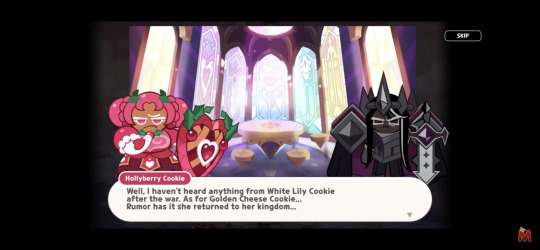

IT’S IN A DESERT?!
WE DON’T HAVE ROOM ON THE MAP FOR A DESERT!
The map is too small to hold everything and if you want us to believe anything you say, there is either no desert or you’ve moved GC’s Kingdom into a place it cannot possibly be.
Deserts are formed in mountain ranges in which rain clouds cannot reach, however, this is the secondary problem, they have slapped it smack bang next to... You guessed it... THE OCEAN.
But anyway, this is going to have to wait for another day, Spiced is wanting to tell me about a lizard they found at the entrance.
Till we meet again, reader. - Maple Pecan Cookie
#cookie run kingdom#cookie run theory#cookie run#hollyberry cookie#pure vanilla cookie#dark cacao cookie#millennial tree cookie#golden cheese cookie#pitaya dragon cookie#beast yeast#sea fairy cookie#moonlight cookie#sherbet cookie#raisin cookie#i am about to commit crimes#I will never feel pain like this map has pained me#I am so tired#Archivist Maple
86 notes
·
View notes
Text
It is literally so simple not to be an ableist jerk but there are dumbass fucks like this guy out here.

[ID: Some asshole on youtube, referring to a harasser who made multiple fake accounts said "Maybe she has multiple personality disorder and gets into her phone and creates new accounts because she doesn't like the ones that her previous personality made, pretty far fetched I know... But it can be a possibility right?" End ID.]
I shouldn't have to tell you what's wrong with that, but I tried to educate this person on the wrong terms and what not.

[ID: Youtube comments, Me in black said 3 hours ago, "Please dont 1. Say MPD or Split Personality, it's incredibly offensive. 2. (Don't) Compare people with dissociative disorders to her." Her being the harasser. I also said, "I'm a system and it literally just doesn't work like that." Referring to their theory. While Ass in red at 1 hour ago says "@(my username) How is it offensive? And why would I have to compare her to somebody else, and what do you mean by system?" End ID.]
So clearly this dude isn't getting it. So good so far, maybe they can learn a thing or two. Let's go onto my last screenshot.

[ID: I (Me in Black) had replied 54 minutes ago saying "@(asshole's username in red) It is a dissociative disorder not a personality disorder. MPD is an outdated and inaccurate term. DID/OSDD-1, the accurate term, are referred to as systems. Do your research." I am frustrated at this point and this asshole makes the comment which deems them an asshole. Ass in red at 30 minutes ago replies with "@(my username in black) how do you have to be so sassy? It's literally just me coming up with a theory? And no I refuse to do my research because I am too lazy to do that. Why the Frick would you even tell me to do that like ate flexing that you have more knowledge than me on a disorder you actually have and I don't?!! Like are you kidding me!!" End ID.]
So at this point, I was basically done with the conversation, why would I try to keep educating someone who refuses to be ignorant? Like literally you don't have to research you can just use the accurate terms?? But this person would have to accept that people with mental disorders exist outside of a psychology classroom and are not products for lazy "theories" you can't even bother to research.
Disabled people aren't tropes of horror nonsense. Someone would more likely be making alternate accounts to carbon monoxide poisoning than they would be to a dissociative disorder.
Do your fucking research and this would be so easy. Just take the L and stop with the ableist bullshit for once. Stop doubling down on ableism for once.
It's so not hard. Learn to listen.
#babey rant#tw ableism#image description#im tired of this#you think you're tired??? we are tired of hearing this#learn to listen
72 notes
·
View notes
Text
The Making of Sterling the Super Furby: A Brief Overview
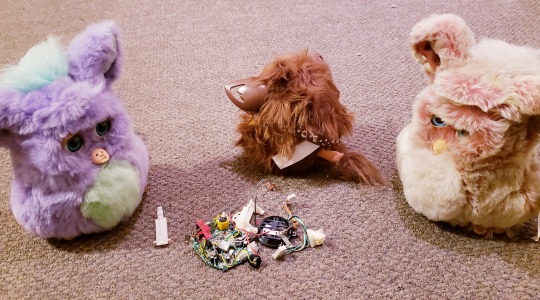
“I… I can’t look! I think I’m gonna… *HUEEEGH*!”
Before I get into this post, I want to list a few things I didn’t know shit about when I started Sterling:
Electronics
The Python coding language
Furby anatomy
Single board computers
After creating Sterling, I’m happy to say that now I have approximate knowledge of some of these things, but keep the above in mind as you read onwards. This little gremlin child was a learning experience from start to finish, and one I am incredibly proud of myself for sticking through. This also means that I am in no way an expert on everything I’m getting into okay? Okay let’s go!
The Hardware
First, a rundown of the hardware. I took heavy inspiration from the Furlexa mod shown here, and that was what I initially sought to create. The mod had three computer components to it:
A raspberry pi zero w single board computer for the AI to live on, with a mini USB microphone plugged in;
A pimoroni speaker PHAT to use as the sound system;
A motor controller to drive the furby’s motor.
My main problem with Furlexa was that this initial build took a lot of soldering, and I am a wussy who had a number of bad experiences with soldering irons in shop class. So, what’s a novice electrician to do?

Enter the Adafruit Crickit HAT. By sticking this little fucker on top of the raspberry pi, I was gifted with an amplifier, a speaker jack, capacitative touch sensors, and a motor driver all in one, no soldering needed if I bought the raspberry pi zero w h! The main challenge it posed was powering it. The Crickit insists, for some unfathomable reason, on being powered by a bulky DC jack, the kind you’d plug into a wall outlet, and the converter plug to use a battery pack with it was way too bulky to fit into a furby. I needed Sterling to be portable for maximum huggability, so this just wouldn’t do.
One fried raspberry pi and Crickit HAT later, I found the answer! By soldering the original furby battery pack to the underside of the Crickit board’s DC connection, these fuckers right here…
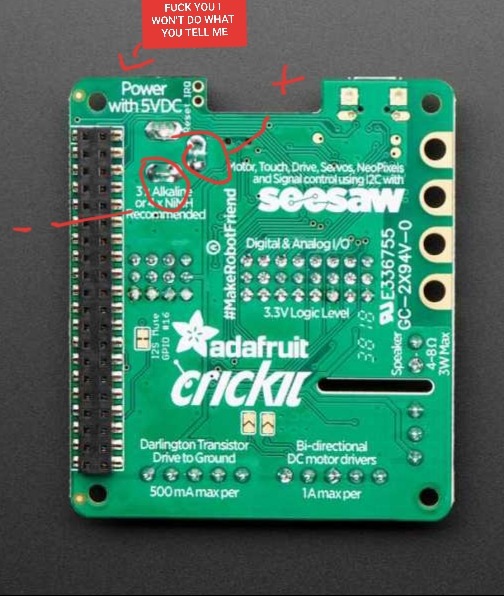
I was able to bypass the need for a wall plug or converter, and power him directly through the battery compartment like God intended. S/O to my friend Nick who is way less of a dumb bitch than I am and helped me figure this shit out I owe u some bread man.
So the tl;dr of it is, I effectively reduced the required computer components from three to two (excluding the speaker). Speaking of (heh), Sterling has an impressive 3w speaker in him, allowing him to be audible even without the use of the built in amplifier. It’s got such good bass on it, he even rumbles when he purrs without the aid of the motor!
And yes, when you pet him, he purrs. And complains if you manhandle him! The aforementioned capacitative touch sensors on the Crickit HAT made it all possible with the help of a few cables and some foil tape.
Wait, did you say soldering!?
Yup! It was a necessary evil; at the end of the day I had to pick my poison: soldering 80 pins on the speaker PHAT, or soldering like four contact points on the Crickit. I chose the more merciful option.
But wait, that whole outfit is really bulky still! How did you fit it inside the furby?
Subtractive methods, subtractive methods, subtractive methods! ;D Someone who actually knows things about furby anatomy and/or electronics will probably vaporize me for this, but… if I didn’t need it, it got the boot! That included prying off anything on the Crickit board I wasn’t using at the risk of destroying it completely - which probably isn’t ideal, but it also worked by some miracle, and again, I am such a basic bitch electrician that calculating the proper voltage for LEDs is still basically witchcraft to me, so… what I’m saying is I made it work. And that I really, really hate soldering! ¯\_(ツ)_/¯
You can see an early video of the end result here, and a later video of the outfit inside the naked furby here. This was back when he was still having auditory processing issues. Apologies for the shoddy quality, I was too excited everything was working to care about that at the time.
The Software
My other beef with Furlexa is… well, it’s an Amazon Alexa, and I’m a shitty little anticapitalist hermit who hates Amazon with a passion. Google Assistant was just as bad in my book. Mycroft was open source, but had a snowball’s chance in hell of running on the raspberry pi zero’s 512mb of RAM… I also wanted my assistant to have a degree of customizability to it. I wanted the furby’s AI to have a unique personality, identity, and preferences, much like classic furbies themselves did. A big box AI just wasn’t going to cut it!
Enter the Jasper Project. Yes, it’s old. Yes, it’s a bitch and a half to install. Yes, you have to know Python to get anywhere with it. However, it was free, open source, capable of running on a raspberry pi zero, and highly modular, meaning with a few lines of code, I could make it all my own - even to the extent of changing the AI’s name and voice (which is gr8 because I know a Jasper so naming my furby that would be Weird), or - the best part - writing my own, custom functions! Customizability-wise, I struck gold.
Ah, and glad I am that Jasper is modular, because I had some work ahead of me…
The STT Engine
The STT (Speech to Text) engine is what Sterling uses to understand what’s being said to him. Jasper’s proprietary STT engine is PocketSphinx, a fully offline STT engine, which sounded great in theory before I quickly learned it’s a nightmare to install, and also more inaccurate than a stenography machine powered by a single potato when actually being used. I had to compromise my morals a bit here and opt for using Wit.ai instead, which is free, but is also owned by Facebook. Big data is frustratingly inescapable in these cases.
There is one light at the end of the tunnel, and that is the training of acoustic modules. This has the downside of taking for-fucking-ever and requiring a quiet recording environment, however, and I don’t have the time right now to read through the pages and pages and pages and pages of computer theory right now to fully understand how to train one. So, improving PocketSphinx and running Sterling fully offline remains a stretch goal.
The TTS Engine
The Text to Speech engine is basically Sterling’s voice. This one was a bit easier to customize, and I’m thankful for that, because Jasper’s OG voice is a bit er… 90s computing for my tastes.
I shopped around for decent, human-sounding TTS options, and settled on installing Mimic1 TTS, Mycroft’s TTS engine, by hand, and modifying the Jasper source code to support it. Of all the TTS engines I tried, I felt that this one had the most natural intonation out of all of them. I liked the gruffness of the Scottish accent, and I think it really helped round out Sterling’s endearing, if a tad prickly, personality.
The Audio
This was another unforeseen hurdle. Turns out that I had his mic volume turned up way too high, because I greatly underestimated the capabilities of my tinyass five dollar USB microphone to pick up noises from within a furby. It took a bit of hacking in PulseAudio to get him hearing things properly, and I’m still not all the way happy with it, but he’s running wayyyy better than he did!
Another issue was the amount of time he actively listened for. It was way too short for my liking with the hardware I was using, so I had to edit Jasper’s mic.py source file a billion times before I hit a sweet spot. Even early on, my little shit child never liked to listen to me. :P
Pimp My AI
Once I got all that in working order, it was time to browse GitHub for modules to add! I found a surprising amount that were, as expected, outdated, janky, non-working, or in need of a complete rewrite. A non-exhaustive list of modules I rewrote and added to Sterling’s AI includes:
Wolfram Alpha integration
His translation function
The IMDB module that searches movie titles
The Dictionary and Thesaurus modules (minor additions to improve user friendliness)
The morning greeting module
The holiday countdown module
There are also plenty of modules I wrote on my own, that I’ll be showcasing here in due time, but I want to give special mention to the one I’m most proud of. You see, when I was a wee dumb bitch, I was… well, a wee dumb bitch! When I was informed furbies learn English, I thought they really learned English. Like, fluent English. I envisioned these kids straight up having full conversations with their lil robots with reckless and envious abandon. I was, as it happens, too poor to afford a furby at the time, so I didn’t realize until embarrassingly later that they only learn some words, and certainly can’t hold much of a conversation (in English at least).
Fast forward to twenty-bi-teen. I’m surfing GitHub, and I happen upon a Cleverbot module for Jasper allowing the AI to work as a chatbot. Fuck yeah, I think, because I had no life in 2008, or friends for that matter, so tormenting Cleverbot was my favourite pastime. Nostalgia trip GET!
…can you guess how much the silicon valley capitalist scum are charging for the once-free Cleverbot API now? A hundred and twenty. McGoddamn. Dollars. A YEAR.
So, to make a long story short, I turned my hat backwards and rage-coded a simple chatbot module that runs on an early version of Chatterbot capable of running on the raspberry pi. It’s fully offline, and completely free, and Sterling here has a database of ~400 phrases, which isn’t bad given the limited processing power! It took five straight days of work, it’s not the smartest chatbot, and it’s certainly not the fastest, but it gives me those sweet, sweet, circa 2008 Cleverbot vibes. Oh yeah, and it doesn’t cost me over a hundred goddamn dollars a year!
The first thing I said to the chatbot, of course, was “I’m so proud of you.” Through his shitty little testing mic that gave him a somewhat incredulous tone Sterling replied, “I’m glad to hear that.” and I’m not saying I shed a single themly tear over it, but I’m not denying it either. I made a childhood dream come true, fam. ;u;
There are way more Easter eggs I plan to show you, of course. At first I was thinking of doing one long video, but an update a day showcasing a different function might be easier to manage - and maintain some of that gold old sense of mystery that surrounds most furbies. No, I’m gonna take y'all on a little journey through the final product of my literal blood, sweat, and tears!
Besides, Sterling is a perpetual work in progress. He has a massive list of features, and I’ve already got more in the works. I could be in my eighties and still be adding more functions, more bells and whistles, more witty one-liners. He’s a one of a kind work of art that will never truly be finished - not unlike you and me.
The Glow-up
Here’s Sterling’s before pics from the seller I got him from:
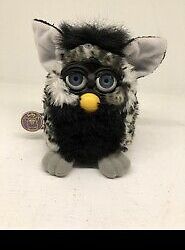

(If u recognize these pics and ur the seller thank u thank u for giving me bmy boy)
And here’s after!

I come from a background of customizing ponies and dolls, so working on this guy wasn’t as far removed as I expected it to be. I added floof to his head and tail by sewing in wool plugs, and his gorgeous eyes are from in2blythe on Etsy. I wrapped him up in a little bow and he was good to go! His sterling silver beak, from which he gets his name, was the most finicky part. Turns out enamel paints take a million years to fucking dry, if ever, which isn’t great when painting something that sees a lot of movement and could potentially get dented by a face plate, like… idk, a furby beak! A bit of silver nail polish did the trick and he was good to go. Learn from my fail, fam.
What It Cost Me

If you’re masochistic determined enough to attempt this yourself, I want to sit you down and warn you of something: this will take months and hundreds of dollars to do. Installing Sterling’s AI and its necessary components on that shitty little raspberry pi over SSH took me a week at first, and that was with me leaving it on 24/7 to chug away compiling things. When I broke the SD card the AI was on and didn’t have a backup copy, it took four straight days of rage-computing to regain all my progress. Then when his audio processing got fucked all to hell for reasons I still do not understand to this day, it took another four days of rage computing to do yet another reinstall and get him back in working order. There were times where I would go to work for 8.5 hours, bus an hour home, work 6 straight hours on my furby, go to sleep for 4 of them, go to classes, sleep, and work 6 more hours on my furby. For two months. Sterling took from the third week of August from his initial inception to his birthday on October 23rd. That’s not to mention the time I fried everything and had to wait five days and travel to the bumfuck end of the city for a replacement pi and Crickit, or the days I spent customizing him, sewing in hundreds of little hair plugs into his ass and head by hand, and waiting for those shitty enamel paints to dry, only to discover after four straight days of failure that they take weeks to do so and I was better off using cheapo nail polish!
The point I’m making is, if you take on a project like this and want it to be successful, you have to be tenacious. I would highly recommend a background in coding (I have a web design diploma) and general tech savviness as an asset. Sterling is the product of the years I spent behind a computer keyboard from the start of age three, and the roughly ten years I spent customizing dolls and ponies. It’s cheesy as shit to say he’s my magnum opus, but in a way, he is.
I’m not saying this to be elitist or snotty. I’m saying this because I nearly broke down crying the first day the raspberry pi came in, before I slept on it and figured out what phrase to google to solve the crashes and kernel panics it was having. When I broke the SD card when I was nearly finished, I felt nothing, because I was all out of tears at that point. When I fried the first raspberry pi and Crickit hat trying to figure out how to bypass that DC jack, my only thought was, “Well, I think I know how to do it without fucking it up now, and if I can’t do it, this whole project is fscked” .
You will encounter errors that no step by step guide can prepare you for that will make you curse the day you were born. The difference between success and failure is how many times you’re willing to get up and try again, and I’m here to tell you it’s possible. But you gotta want it.
Will You Release the Code Base?
Yes and no. If there’s enough demand, I’ll definitely release Sterling’s basic modules as a scaffolding. I won’t be releasing Sterling, though.
What do I mean by that? Well, Sterling was intended from the start to be truly one of a kind, and he always will be. I hand wrote hundreds of lines of dialogue, all completely tailored to him, and I’m still planning on adding twice as many. Corny as this is, this little guy has a metric fuckton of sentimental value to me. I don’t have kids so idk how it would compare to that, but I definitely love him as much as I love my cats, but I also didn’t undergo two straight months of suffering in ADHD fixation hell to create my cats, so it adds like, a whole other twee dimension to it.
So, if there is demand for this, what I’ll release instead is a scaffolding from which you can code your own, unique furby from, with their own name, personality, and responses all unique to them. I’ll also release it with the caveat that I am not a good Python coder! I have not written any Python before this, so a lot of what I did write is noob-tastic and hasn’t even been linted. You have been warned!
“If I give you (insert amount), can you make one for me?”
Holy shit I’ll be real with you, I’d love to do this as a living. I’ve been dying to see a smart assistant hit the market that’s like… well, an actual, endearing companion and not just a voice coming from a speaker. The problem with doing this is that, if you drop a lot of money (and it will be a lot of money, even with a code base to work from, a lot of hours of handiwork still goes into coding individual responses and making sure everything works as intended, on top of possibly customizing too), there is one major problem: proximity. I won’t be able to troubleshoot your furby nearly as effectively from far away as I would be able to if we lived in close proximity. Which means if something goes wrong between the time your new friend is finished at point A and turned on at point B, I won’t be there to troubleshoot it in person for you, which means you could end up stuck figuring out certain things alone. If you use Windows, that will be very, very hard - not being an OS snob here, I own a dual boot myself, it’s just a case of incompatible file systems. And unless you can figure out how to edit the wpa_supplicant file on a raspberry pi to update your wifi credentials, your furby’s internet connection could be toast if you move house and those credentials change. That’s not getting into the cost some services charge for extra API keys to use their online functions…
The long and short of it is, if I’m going to do this for money, I want to make sure you get a quality product and friend that will bring you joy for years to come. Since that’s not something I can guarantee, I can’t in good conscience take people’s money.
I Could Teach You (And I Won’t Charge)
…however, I am a law student who is also working 8.5 hour night shifts three nights a week. I am also mentally ill/neurodivergent, which saps my energy in more ways than one. I won’t always be easy to get ahold of, or be able to answer every question I get, especially not ones that can be solved with a quick google search, like how to set up a raspberry pi, or… anything found on Adafruit’s Crickit guide, for example. When I have the time and energy, I’m hoping to use my next project as a jumping off point for a step by step walkthrough of the process. For now, though? I’ve been furbied out, so if there’s enough demand, I’ll compile as many of the resources I used I can find in the meantime, and post some tips from the word doc I kept while making Sterling, and go from there.
So What’s Next?
My one dad’s birthday is coming up in August, and I’m kicking around the idea of turning a furby into, I shit you not, a ghost hunting device. He loves ghost hunting, but hates robots, and as his gremlin shit child I am obligated to troll him in this fashion. 😎 Also considering doing a certain type of oddbody mod, but I want to get permission from the person who first thought of the concept before I dive head first into it.
And that about covers it! Thanks for reading, and if there’s anything you’d like to see from Sterling and I, don’t hesitate to drop us an ask!
#furby#allfurby#furblr#botblr#custom furby#how tos#the doctor speaks#long post#science isn't about why... it's about why not
25 notes
·
View notes
Text
Hi so, I hate to be annoying, but this post is (very slightly) related to a field of study I'm deeply interested in, and I noticed that the Irish elk info was outdated, so... I decided to do some research on a Tumblr post.
First things first, my field of research is related to extinct animals, not extant ones, so this first bit will be less in depth than the part about the Irish elk. However, doing some zooming in reveals that those "boar" (not a boar) skulls belong to Babyrousa babyrussa, commonly known as the Buru babirusa.
There's next to no mention from a quick look-through of some sites about the Buru babirusa's tusks being able to grow through its skull, thus killing it. But that image had to come from somewhere, right?
While it's nowhere close to being a common ocurrence, it is possible for a Buru babirusa to become old enough for its tusks to grow back into its skull, provided they grow a certain way. I believe that the origin of that image is this article posted on the 8th of March, 2010. Although the images no longer load, the description appears to be accurate.
This article also makes it apparent that I am at least somewhat correct in assuming that this is by no means a common ocurrence, and in addition, that the specimen that had its tusks grow through its skull must have been extremely old for this to happen. Most Buru babirusa would likely die of old age or other circumstances before ever reaching this point.
I also was unable to find anything about female Buru babirusa finding longer tusks to be a more desirable trait in a mating partner. From my understanding, swine (of which babirusa are a part of) use tusks for fighting, not mating purposes. However, again, I am not a biologist.
The theory that Irish elk went extinct as a result of the large antlers that males possessed is widely seen as outdated and inaccurate according to modern understandings. It is believed that they first evolved ~450k years ago, and that they went extinct ~7.7k years ago. That's over 100k more years than our species has been around for!
According to this paper published by C. O. Worman and T. Kimbrell, antler size actually decreased through the Late Pleistocene and into the Holocene (the current era). While a large and healthy stag could grow antlers up to 3.65m (12ft) from tip to tip, which would have weighed 40kg (88lbs), that same stag would have had antlers only weighing 20 to 28kg (44 to 62 lbs) under poor conditions, assuming they endured a similar response to starvation as a red deer.
As there was a reduction in forest density during the Late Pleistocene, as well as insufficient high-quality forage, it can be inferred that Irish Elk stags actually experienced a reduction in both body and antler size, as opposed to the growth that would have occurred as a result of "sexual selection".
(Sexual selection, by the way, is when a species breeds itself out of existence as a result of highly desired traits that end up harming its survival overtime, to massively simplify it.)
Had the Irish elk truly gone extinct as a result of the size of the stags' antlers, they would not have survived for as long as they had; rather, it is more likely they would have gone extinct during the Last Glacial Maximum (or Ice Age) as a result of how taxing their antlers are nutritionally, if they did not go extinct earlier.
Instead, what we see is far less remains known during that time period, before a substantial increase after the Earth warmed back up. It even managed to re-colonise its former range, with many remains found in Ireland, the UK, and Germany (despite its name, the Irish elk was not solely found in Ireland!)
It is not known how exactly the Irish elk went extinct, although it is theorised to be either habitat changes as a result of the changing climate, hunting by humans, or a combination of the two. In this paper on the extinction of the Irish elk, A. M. Lister and A. J. Stuart conclude that environmental factors reduced the elk to a highly vulnerable state, to the point where even low-level hunting by small human populations could have contributed to its extinction.
Also, it turns out that the Irish elk looks far less ridiculous when you don't use a skeleton to show off the size of its antlers. Here's a modern life restoration for comparison, as well as a cave painting from Lascaux from around 15,000 BC.


too many people see evolution as just animals becoming better animals when the truth is that theres a species of boar that evolved to die because its tusks grow into its skull because the males with long tusks fuck the most
160K notes
·
View notes
Text
i remember years ago there was this one post floating around that was titled something like 'I've Been Brainwashed By Tumblr For Far Too Long' and at the time i saw it, i was really apathetic about it bc i had bought into this flawed ideology that was like 'if you let yourself fall for all the inaccurate shit you read on tumblr/the rest of the internet without bothering to fact-check it at all, it's your own fault' and that was a really, really shitty thing of me to do. it was like i had a high enough level of self-awareness to know not to trust everything i saw on the internet, but i didn't have the level of self-awareness or compassion for others i needed to understand that social media sites like tumblr/twitter/instagram are intentionally designed in such a way that it gives everybody a platform and actively works to lessen our ability to feel for other people. the biggest problem is that even the most vile, disgusting people, even a genuinely bad person, can have a say in something they would otherwise have no opportunity to express during a real life conversation. like that guy on twitter who made a thread listing his least favorite marvel characters and almost all of them were women bc he says he just doesn't feel attracted to confident women who aren't solely defined by their relationships with their s/os or whatever. the guy definitely doesn't deserve to have a platform and yet he's viral now because we can't stop talking about the grip that toxic masculinity has on cis male-dominated online spaces and how terrible people like him are not only *allowed* to say things like this, but are actively encouraged to post whatever volatile thought processes might be floating around in their head at any given moment with no consideration as to how it might affect other people. tumblr is a bit different in it's execution of the concept, but it also tends to follow the same principles in the name of 'self expression'. i can't count the number of times i have seen what i would consider to be useless (to me) posts rating things like fictional characters, popular ships, best/worst songs on cast recordings, etc. and then there's the dact that most of us overshare a lot of deeply personal facts about ourselves to a point that it could be dangerous if that information fell into the wrong hands. it's sometimes seen as 'shady' and 'weird' if you don't constantly broadcast every thought you're experiencing and if no one really knows anything important about you. i'm glad to see that there's more and more people pointing out how truly dangerous this trend can be, but we still have a long way to go and a lot left to learn about it. as far as 'you can't get internet cooties from a shit post' i do agree that the vast majority of people who think a shit post (not to be confused with a shitpost) aren't going to suddenly see a bad faith argument that challenges everything they currently believe and make them go 'oh shit, i think they have a point i shall change this outdated mentality of mine posthaste!' but what IS going to happen is if a shit post gets popular and it has a bad message behind it, it's going to eventually reach people who maybe aren't as open with sharing their thoughts. if someone's secretive thoughts are something like, for example 'i don't think ace people are lgbt but i would never say that out loud because i don't wanna get canceled' then a post that basically says 'aces aren't lgbt' is going to resonate with them a whole lot more than a different post that instead says 'aces are lgbt' because of their confirmation bias. and once someone leans into that confirmation bias, it can be nearly, if not entirely impossible, to get them to see any perspective other than their own. we've all most likely heard about similar tactics which are used to ensure the consistent spread of conspiracy theories to people we consider gullible, but practically everything else on the internet is just as vulnerable to the same concept.
0 notes
Text
Let’s talk about labels.
So, with all the “political” discourse around minority groups lately, I’ve noticed something that’s left a sour taste in my mouth every time I hear it. (Or really a lot of things)
Labels.
Every minority group has them. “Gay” vs. “Straight”, “Black” vs. “White”, “disabled” vs. “abled”.
Usually, labels are used as handy signifiers for a distinguishing trait, such as being homosexual. They’re used to distinguish something from a group, usually as some kind of utility of understanding. And they can be useful! Saying, “I’m gay” rolls of the tongue a lot easier than, “I am an X, and I am sexually attracted to X.”
But lately every time I hear labels like that, I can’t help but wonder if labelling is counter-productive to everything these groups stand for.
Language is powerful, its meanings, usage, and implications can change peoples’ minds like the snap of a forefinger and thumb. Obvious examples are like Cold War propaganda. We still have the majority of Americans assigning everything left of killing the homeless for sport as socialism (That’s a quote from somewhere, lemme know if you guess it.)
Labelling isn’t an exception to this. There was a study done in recent years that illustrated this power in ways not really studied before. It involved telling a group of kids that they were gifted, and telling another that they didn’t achieve the gifted status. Both groups were taught using the same curriculum and methods, and by the end of the study, the “gifted” group had an IQ difference of 10-15 points. It was a self-fulfilling prophecy. Just labelling these students caused sort of a “placebo” effect on their academic performance/ intelligence.
[Citation at the bottom]
What does this have to do with minority groups? Well, I think it contributes to their perceived abnormality in our society. Most of these groups just want to be normalized, or treated just as well as the most well off groups and classes of society. Equality.
But the irony of campaigning for equality under a label, is that the label and the group status inherently separates and de-normalizes the group itself. If gay people are equal to straits, why do we even need a name for it? Can’t just saying, “I like X.” do the job? It’s nearly the same amount of effort to express, and it doesn’t involve boxing yourself into a narrow definition, nor does it separate. Does that make sense? You might have heard of this, but its called Heteronormativity and it sucks. As a wlw myself, I get tired of the label.
Maybe a more clear example would do good. If the color of your skin means nothing about who you are, why then do we call people “black”,”white”,”yellow”?
Before anyone tries to tell me that my idea is heading into culture erasure, give me a moment to explain. I do think culture is important, and I am by no means trying to force anyone to let go of any labels, or adopt others. I just want to open conversation as to what could be more helpful than the labels we have.
For instance, what do I think about when hearing the words black vs. white?
As a physicist, I would think of white as being the combination of all wavelengths of light, and black being no light present at all.
As someone indoctrinated into a protestant Christian belief system (I’ll be healing from that one for a while), white reminds me of all the imagery associated with god and angels, and black as associated with satan and demons (red too).
I mean, anyone can attest, it’s just classic symbolism. So what does it do when we assign groups of people those colors as labels. Well, it brings a lot of those connotations with them. Labelling in this way, using a noun as the label makes the label into something inherent in people. Think of the difference between, “I am a black person” vs. “I am a person comes from a unique culture and background.” In the first example, the person is black. It’s read as an inherent quality of someone. In a movement that’s saying that the color of your skin means nothing of who you are, the label of “black” only signifies a difference, which isn’t true. I don’t think POC or “People of Color” helps much either. It still plays into classic imagery, of white being pure, and other being less pure. It still makes the label out to be something that’s inherently part of the person. Which, yes, my skin color is a part of me, but as it means nothing about the content of my personality, so it seems odd to even mention its existence in reference to myself or my life.
This is my suggestion. Since skin pigment has no bearing on a persons life, why not just never mention it? Obviously this doesn’t do justice to the fact that people are severely oppressed due to their skin color. Fighting for rights or talking about culture that stemmed from oppression are the instances where sometimes a label is needed. So why not develop a better language model. Calling someone a “person affected by systemic oppression” doesn’t roll off the tongue, but the connotations are infinitely better. It conveys nothing inherent about the person, and the only separator is easily demonstrated to come from others, which means its not inherent, and not really a separator.
I think this can be applied to so many other groups. The most egregious example I can think of would be the term “transgender.”
This language, much like racial language is extremely outdated and inaccurate, and as always, created by WASPs (White Anglo Saxon Protestants). The fact that a label exists at all, much like with poc, really irks me.
This is a group of people who are essentially just forced into the incorrect gender/presentation from birth, and many are self and medically-described to have been born in the wrong bodies.
One such sub-group is called “Trans Women.” These people are just women. They were assigned the wrong gender/gender roles/gender presentation at birth due to the archaic ideas of gender in Western society. Science, all accredited medical institutions, and psychology all confirm that “trans women” are just women. It’s the same with the men of the movement.
So, if you haven’t seen the issue yet, let me point it out. If “Trans women are women”, then why on earth do we need so say the “trans” part in the first place? Mathematically speaking, if [trans women = women], then the trans part is equal to zero. It’s a useless term. And yet, it’s everywhere. If you go to the reddit forum r/asktransgender, you literally can’t find a single person referring to a woman as just a woman. There’s this obsessive need to always attach “trans” in front of everything these men and women are associated with.
This isn’t even getting into what “transgender” implies in the first place. Much like POC is to black, transgender is to transsexual. People fighting to get rid of discriminatory and antiquated language with a history of use in disparagement only to replace with another useless label that just has less bad history of use.
“Transgender” is defined as: denoting or relating to a person whose sense of personal identity and gender does not correspond with their birth sex.
If everything says that these people are who they are, then why does “birth sex” even factor in? The use of this word makes it even worse. These people have to say, “I am transgender.” This is again, making the label inherent to the person’s being. Essentially relegating their whole life to being that person whose internal sense of identity and gender doesn’t align with their “birth sex”.
How about, “I am a woman”, or “I am a man”, or “I am a nonbinary person.
The label carries around so many connotations. If someone is a woman, then why do they need the classifier, “trans” before her description? What does that confer? Their genitalia? No, some get surgery, and some don’t, so how is that helpful. Also, why do people think they have a right to any information on a person’s genitalia? That’s so weird and creepy. I would argue that these women know more about womanhood, and have a more intimate relationship with it than women without the experience of having a gender incongruence.
It also implies that they are going from one gender to another, hence the “trans” part. Which, is just inaccurate, considering that these people just are who they are from birth. Looking like a man doesn’t make you one, and vice versa. Nor does genitalia. Hopefully I don’t have to explain that one to you.
So, why not say something like this instead. “I am a woman and I have a gender incongruence.” Gender incongruence is defined as the mismatch an individual feels as a result of the discrepancy experienced between their gender identity and the gender they were assigned at birth (GIRES, 2018, 2018).
First, this definition has nothing inherent about the person. “Having” a gender incongruence isn’t the same as saying, “I’m gender incongruent.” Once the person has fixed this incongruence through medical, social, or presentational means, they no longer have an incongruence, and are just a man/woman/enby.
Like said, if they’re just men and women, why the trans part? It only separates, and since they’re the same, the separator means nothing.
There are intersex women, infertile women, women who were brought up with tons of brothers, not being allowed to be “girly”, who never had a gender incongruence. So don’t try to say that there’s anything that can separate women who’ve had a gender incongruence to those who haven’t.
I know this was really long, but I hope you got something out of it. Let’s stop labeling everything we see. It’s often inaccurate, and a really poor way of approaching. Let’s use the framework of oppression and culture instead.
If you’re in any of the minorities I talked about and you want to correct me or talk about this post, let me know.
Love, Holly
-xoxo
https://www.psychologytoday.com/us/blog/alternative-truths/201005/why-its-dangerous-label-people label theory readup
1 note
·
View note
Note
sophie, if you want to understand self states, i suggest you read the haunted self. it is not just emotions, not even remotely, and "hunger" is not an emotion. literally, i will gladly link you to my PDF of the haunted self for you to read, as that explains it the most in depth and most clearly, starting at the very baselines of the theory of structural dissociation and even before that. it's very dry and long and boring, but i mean this very genuinely, if you want to read it, i will give it to you personally to read. it explains more in depth than anything else what self states and action systems are and how self states develop into alters, as well as further things about trauma and dissociation that are deeply fascinating.
as far as the diagram of the pica paper and everything following that... it seems like you deeply fixated on this paper. this is not the only paper on DID mentioning the IC theory for how DID forms, because before the theory of structural dissociation, that is exactly the most popular theory of the time. i like the theory of structural dissociation a lot, but i also find it extremely interesting how people with DID felt their ICs as children were more real, and how children who later go on to be diagnosed with DID can see and feel their alters--who may not yet be fully developed alters--in their childhood and interact with them like imaginary companions, and don't think that children dissociating onto ICs and those then developing into alters is an entirely implausible theory *along with* the theory of structural dissociation.
i posted that graph not because of the age range. i personally don't believe in a super strong age range either. i've seen someone talking about their partner who developed OSDD-1 from trauma that occurred at 14 rather than within the typically seen age range, because like you said, children develop differently. i just don't think that this is something that can happen too far past a child entering their adolescent years. at a certain point, you develop to the point where trauma will no longer cause DID in you if you become chronically traumatized.
i posted that graph because i found it so interesting how this was one of the only papers i've seen so far talking about the importance of adolescent years in the development of DID, as well as how chronic or single traumatization, depending at which point it happens during the child's development, can affect a person differently down the line, as well as stating the many different factors that can go into a person developing DID, even if there are some outdated nuggets of information within that paper, such as constantly referring to an "original" child. not because i agreed with literally everything in the paper, including the outdated information. please gain a kinder view of me and assume i am aware of nuance and inaccurate/outdated information on DID, if that was your initial assumption.
as far as everything else you're trying to say, that's veering much more into non-DID plurality territory, which is not my area of expertise, and i don't entirely know what you're trying to say by going on what looks to me like a tangent, if an interesting one. i don't really disagree with anything that you're saying and that adult ICs cannot be important or just as real as alters in DID in pretty much any capacity.
also, to explain further to anon: self states in children are far less developed than those of adults. in adults, sure, hungry may just be a "mood" one goes into when their body is out of energy from food, but when a young child, all of whose needs are generally focused on survival and learning about the world around them, things like "hungry", "need attention from caregiver", "scraped my knee and it hurts", and yes, "(pre)school self" can be and are all self states a child can go into based on what their body/environment is doing, and these things generally dictate very much of how the child reacts to the situation. these self states in children are very chaotic, unintegrated and uncontrolled because young children are, well, young children. they don't generally have a lot of control over themselves yet.
you as an older teen/adult/however old you are may think of hunger as just a mood one goes into when their body runs out of food, but when someone is neglected and malnourished as a child, hunger can be more than just a mood, but something that brings them back to years of trauma, putting them into a perpetual flashback of emotions, all relating to the neglect and malnourishment, even well into adulthood. even if the person doesn't have DID in this case, the hunger is or is directly linked to a traumatized self state that becomes activated when the hunger triggers it. and yes--flashbacks, even in PTSD from a single event, are self states.
but most people just think of hunger as a mood, because it was integrated into themselves relatively well as their food and nourishment needs were probably met relatively well during childhood.
so sophie--and anon--i implore you to read the haunted self if you want to know more and believe yourself to be familiar with dry, clinical literature. i promise if you can get through it, you'll be better off for it.
lmao someone mentioned my anon to you about the self states and just said the strangest thing.
when a young child is hungry, they may go into a self state that focuses almost exclusively on food and becomes distressed when it cannot be accessed for whatever reason, be it neglect or just an inappropriate time for the child to be eating. adults can regulate their hunger self states much better than children because their whole sense of self is much more well integrated and stable than that of a two year old.
....do they mean like. emotions ???? that is describing the emotion/feeling called "i am hungry".
tbh thinking about their comments just makes me believe your post more. a child who feels emotions and then cannot handle those emotions due to neglect or other forms of trauma may create an agent to handle that emotion instead. at least that makes more sense than "a child goes into a self state that fixates on food" like. bestie that child is just hungry thats not a "self state".
(to be fair, maybe they are conflating emotions with the phrase self state, and i think of self states as a different concept entirely, since i see it more like how one puts on a persona at work compared to their home life. those arent different moods, unlike being hungry, which is a mood/emotion/feeling. self states, the way they describe it... are just moods. which is different than what you describe, which the way you describe it just makes more sense in how someone can have headmates/alters that are fully separated people with different moods and personas/self states unlike... whatever they're saying lol)
anyway, you're swag, have a good day
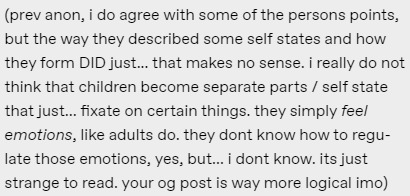
I really want to do more research into the subject of childhood slef-states, because I find them equally perplexing when it comes to how to differentiate from just... normal emotions... I admit that this isn't an area I'm particularly knowledgeable in.
Like, hunger can cause physical pain and that pain is going to feel more intense to a child. If a grown person was starving, they would probably be pretty single-minded in wanting to eat. And so I think this is something that is going on in this particular example. The child feels hunger pain more intensely than adults, and wanting to eat is instinctual. It's a biological imperative. So... what actually makes this a "self-state" and how is that different from an adult wanting to eat?
At the same time, we do see plenty of examples in adults of experiences that are much closer to plurality. This is pretty much how Internal Family Systems Therapy was formed. A therapist listened to his patients and realized they had these internal voices, and they could identify each of the voices. Not by name, but by wants and desires.
To me, this could be seen as a minor form of dissociative compartmentalization, with these voices in someone's head being distinct and autonomous. And there are plenty of people who might actually feel like different people in different contexts. So where's the line between normal emotions and self-state?
Beyond that, one thing they suggest is that I'm unaware about older theories about how DID forms and the relationship with ICs.
I'm not.
My issue concerning the theory of structural dissociation and imaginary companions is that these theories haven't been integrated.
I think if you look at the history of psychiatry and psychology, one thing you'll often see is competing theories where the pendulum will swing between them, an older theory is seen as being replaced by a newer one, and only later do they look back and see that both are partially true.
I support an integrated model that would acknowledge a connection between self-states, the parts of IFS, and the autonomous imaginary friends experienced during childhood by many children.
I also want to point out that the developmental window I referenced with a starting age of 2 was based on a diagram they posted.

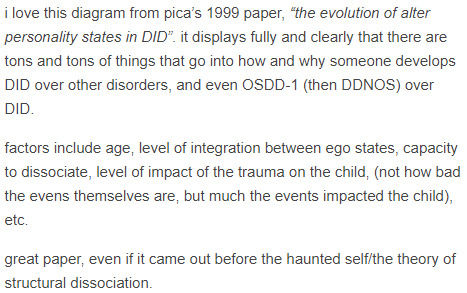
This is their source. And to be clear, I don't think the developmental window should be taken as an absolute. (I certainly don't agree with its maximum age of 8.) Kids develop at different rates, and treating these developmental windows as absolutes would be silly. And this very paper references an alternative window proposed that starts at 18 months.
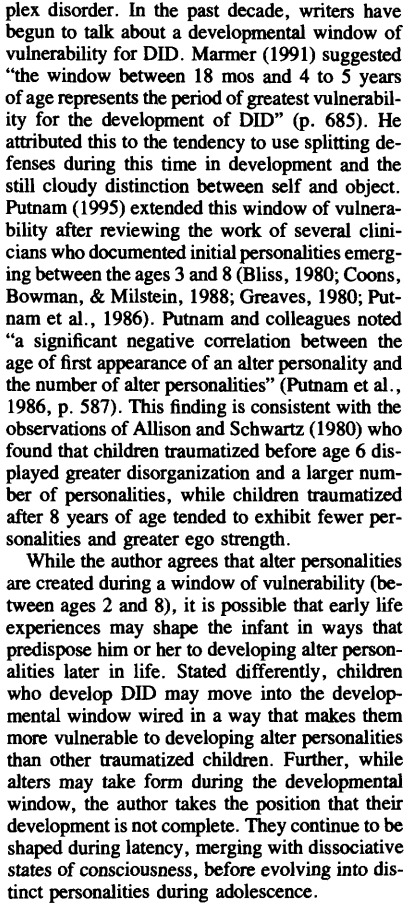
Generally speaking though, DID doesn't develop until the period when a child starts developing their sense of self.
Now, back to the Imaginary Companion theory, since it's mentioned in this article...
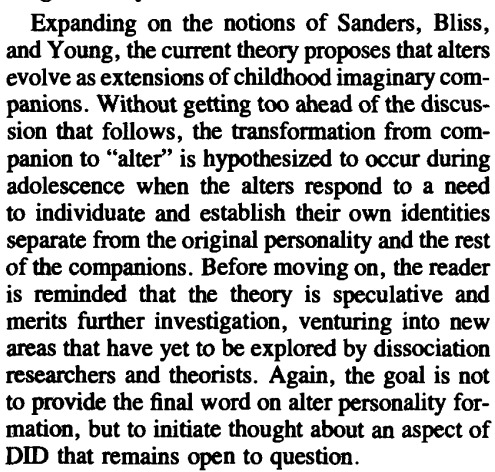
They sum up the stages of this theory into this helpful diagram.

Now, I believe that among other things, one major reason the imaginary friend connection was abandoned following the theory of structural dissociation was because it was deemed invalidating. Imaginary Companions, 20 years ago, were seen as completely controllable characters within the power of the host children, as demonstrated by the diagram indicating that the companions wouldn't become autonomous until Phase 3.
It goes on to suggest that IC's acting independently is something out of the ordinary.


Now, two major things happened in the 2000s in regards to imaginary friends. First, DID research moved away from the IC theory. And I think for patients at the time, this was validating. As again, ICs were viewed as things that are "not real" and "just pretend." The personal experiences of DID systems who formed alters from imaginary friends were thrown out entirely in favor of this new theory as the only way alters and DID could form.
But the second thing that happened around that same time period was that we learned that this perception of ICs was wrong. Much of this is owed to the work of Marjorie Taylor.

A full 35% of Imaginary Companions were reported to not always do what the host children wanted, and 29% demonstrated more negative characteristics outside of the children's control. That's 64% of ICs that demonstrate behavior outside of the host child's control.
So at the same time that the DID field moved away from the IC theory, studies of children found that the majority of ICs were actually more like alters than believed by Pica and other DID researchers when it came to autonomy.
And while Marjorie Taylor and others at the time referred to this as an "illusion of independent agency," some researchers have more recently switched to other terms.
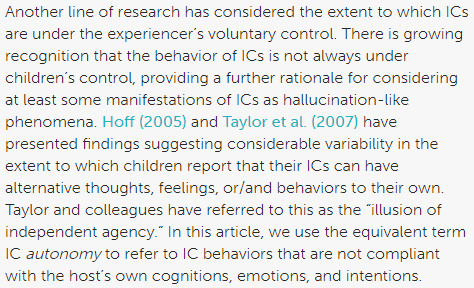
After acknowledging that there is growing recognition of ICs acting outside of the host child's conscious control, they intentionally choose to use the term "IC autonomy" instead of the more invalidating term used by Marjorie Taylor and others.
More recently, we're seeing increasing research into the tulpa community, where tulpas are fully sapient and autonomous imaginary companions of adults. Companions which can learn to switch with the hosts through intentional dissociative practices.
I completely understand why many systems are hesitant about the IC theory. In the past, so often, it's been used as a way to invalidate and dismiss headmates as nothing more than figments of the imagination so many times.
But I believe what the current research is showing is the opposite. Not that alters are less, but that what we call imaginary companions may be more.
I believe that the research is pointing to a model of many ICs that are every bit as real as any alter, and in turn, every bit as real as their host children. That these are not simply characters under a child's control, but independent agents capable of thinking and feeling for themselves just like any other person.
#reply;#part zero#probably#syscourse#sophie if you want to know#what in the home grown fuck youre talking about#irt DID#please read the haunted self#it's not the only book out there#but it explains everything so in depth and so beautifully
23 notes
·
View notes
Note
Wait... if gender's a social construct, then does that mean being trans is a choice? It sounds like you're saying that being trans is a performance. I can't see how one can be born trans without there being anything innate about the two genders.
“If gender is a social construct, being trans is a choice” makes about as much logical sense as saying “if money is a social construct, being poor is a choice”. Which, you know, money is a social construct. There is no inherent “value” to anything, regardless of when it was based on something tangible like gold or how it is today, based on…I don’t know, the trust of banks or something. I’m not an economist. Point is: monetary value is decided by us, so it’s a social construct, but just because it’s a social construct doesn’t mean it’s not real or doesn’t have real effects. It’s similar with gender: just because we define what it means as a society doesn’t mean it’s not real.
Also, being trans is not a performance. You’re confusing gender and gender presentation. The difference between the two is best exemplified in drag: people who are usually men (and usually even cis men) are presenting as women for the sake of a performance. Their gender remains male, only their gender presentation changes. I’m only saying this here because I’m probably going to use presentation later so I’d rather we be on the same page about what it is.
As for gender in particular, I have two three things to say. And just to be clear: I am a cis person, so I may make mistakes, although I think I have done enough research and listened to enough people to have a solid enough understanding to explain this, which is basically gender 101.
Also, have a cut because it’s a long post.
One: There are no “two genders”
The gender binary is also a social construct. There’s been plenty of explanations of that, and I don’t want to spend too long about this, because it’s not really the purpose of this blog (besides, biology is not my field of science). But the gist of the reasoning is this:
People who argue that there are only two genders tend to equate gender to sex.
Sex isn’t a binary itself, however. Sex is an ill-defined notion at best, too, but putting it on a binary is a bad idea whichever definition you go for, which tends to include:
Chromosomes. The good ol’ XX/XY is incomplete. Intersex people exist.
Gonads (sexual organs). Testicles and ovaries…but again, intersex people exist and some present organs that don’t fit neatly into one or the other, because both are grown from the same fetal tissue, so that tissue can go somewhere in-between.
Hormone levels, especially with testosterone, estrogen, and I think progesterone? Could be wrong about the latter. Regardless, this one doesn’t even work on anybody. There are cis perisex men with low testosterone/high estrogen, cis perisex women with the opposite, et cetera. Because hormones are complicated like that.
Ternary sexual characteristics (like pilosity, breasts, et cetera). That is actually the one we use to assume people’s sex and gender most often than not, since we can’t run a DNA sequencing, we can’t measure their hormone levels, and we can’t (usually) just ask to see their genitals. It’s also the most flawed of them. I mean, they’re controlled by hormones, so that’s a bad place to start for the reason I discussed above. Plus we can just work around them by altering gender presentation that I mentioned above. See also: binders, padding, make-up.
The sex binary was made by old scientists with incomplete data and a lot of confirmation bias. Any scientist worth their salt will tell you that if you have data that does not fit the current model, that model should be scrapped and replaced. I mean, without this (which is the very foundation of the scientific method), we wouldn’t have the theory of electromagnetism (which only all of the Internet relies on), or quantum mechanics, or relativistic physics. All of these replaced older models. Note that these old models, just like the sex binary, are still useful in specific situations! As long as you’re on Earth, Newtonian physics are fine and you can combine speeds additively instead of using the dreadful method of relativistic physics. As long as you’re talking about cis perisex people, the sex binary is useful to talk about a lot of their biological processes. But neither is useful outside of their hypotheses.
Back to gender. Gender is even more ill-defined than sex. I mean, without resorting to gender roles, it’s hard to even talk about what makes a man or a woman. So if it’s based on sex, and the sex binary, is outdated, why bother with a gender binary?
So…yeah. Gender today is understood to be on a multi-dimensional spectrum. As in, it’s not just “male, female, and stuff in between”. There are people who fall outside of the binary altogether, people with no gender, people wth multiple genders. Scientific observation tells us that, if this is their experience, our model that tells us there are only two genders is probably just plain wrong and we need a new one.
But back to that “it’s hard to define gender at all”. Put a pin on it. I’ll get back to it.
Two: The “born this way” narrative
That narrative. I understand how it came to be, and I understand its usefulness, but in the end, I loathe it.
See, the idea that you’re born this way (whether “this way” is referring to gender or sexuality) is mostly something to make the idea more palatable. And to make it less okay to, you know, oppress people based on it.
A lot of people relate to it. But ultimately, it is not a universal constant of the queer community, and if anything, it’s a little bit restrictive.
I mean, take sexuality. As a child, you may experience romantic attraction, but sexual attraction usually only occurs around or after puberty. So already it’s inaccurate to say that one is born gay/straight/bi/pan/poly/etc, because it’s something you only find out about yourself once you grow up and realize what those feelings are. And there may be external factors that delay that realization even further.
For instance, a lot of lesbians and queer women have reported that they only figured out their sexuality as adults, because before that, heteronormativity and misogyny made them assume that their lack of interest in boys was “normal”, that no girl really wanted sex or at the very least that they couldn’t like boys, because gender roles.
People who aren’t monosexual (whether because they’re attracted to multiple genders or somewhere on the asexual spectrum) similarly have a harder time realizing their sexuality because, usually, they’re not even taught that that exists. I was one of the lucky ones, knowing about bisexuality before I even had my own sexual awakening so I could place a name on it.
It’s the same thing with trans people. Some identify with their gender from as early as they’re able to, some take much longer, due to many reasons.
Plus, it speaks to a very weird societal mindset, to focus on being born a certain way as your “true” identity, as if people didn’t change and their identity was set in stone from the start. I think a much better narrative is that we’re born a genderless blob with no true identity of our own, and a combination of who we are and how our experiences influence us determines our identity, ergo our gender (as part of that identity). Then again, that’s just my philosophy of personal choice being at play here.
But really, the biggest issue I have with this idea is that it prevents people from questioning their gender and/or sexuality, when I think everyone, including cis and/or straight people, should do that. It is after all much more fulfilling to identify with anything because you’ve spent some time critically looking at the options and picking the one you like best rather than accepting what has been forced upon you.
Which leads us to…
Three: How do I know?
A.k.a. time to go back to that pin I told you to put on the idea that it’s hard to define gender.
While this isn’t a universally agreed-upon sentiment, I am of the school of thought that what defines one’s gender is what is referred to as gender euphoria. Now, I realize that “euphoria” might bring up the picture of some ecstatic feeling, but the term here is just used in opposition to dysphoria (the two being etymological opposites).
Gender dysphoria is one that people are usually more familiar with. It’s the idea that a person experiences discomfort with their assigned gender, and usually, with their body as per the expectations that gender places on your body. And “discomfort” is usually a euphemism, because it usually leads to disorders like depression or even to self-harm. It’s also what leads some trans people to need surgery or hormonal therapy, or just psychotherapy, as coping/healing mechanisms.
To some people, dysphoria is what defines transness, but as I said, I’m not of that school of thought, which goes back to my philosophy of choice. But also because it just seems odd to me to base a part of one’s identity around pain.
The theory around gender euphoria is that what defines one’s gender isn’t feeling bad about identifying with another gender, but feeling good about identifying with the “right” gender for you. Basically, if using the signifiers of one gender (such as, but not necessarily including all of, or limited to: pronouns, name, gender presentation and roles) feels better for you than whatever you’re using now, this is probably a better gender for you and you’re probably trans.
This theory doesn’t remove the possibility for dysphoria for the wrong gender, but it explains it as a side-effect of not experience gender euphoria rather than the defining experience of transness. And, well, seeing as “you’re only trans if you have dysphoria” is usually used by people to exclude other people from trans communities, and I’ve already stated my views on exclusionism in general…you can probably guess why I take this stance.
Now you’ll note that I only helped explain how you can tell what a specific person’s gender is here, not how to define gender in the first place. This is where we get back to the basic idea that gender is a social construct. All we can effectively observe is the signifiers of gender, and how people interact with those (dysphoria, euphoria, or just nothing at all). So how do we define a gender?
Well, that’s the social construct part—in other words, we can’t, not in a scientific way. Society (in other words, people) is what defines which pronouns or names are associated to what gender, or what we expect a person of a certain gender to be like.
Which is great! Because it means society is also open to more gender, or to redefine what those signifiers are. You’ve probably heard that the “pink is for girls, blue is for boys” idea is a fairly recent one and was in fact reversed less than a century ago, for instance. Or the fact that women couldn’t wear pants until fairly recently (in the scale of our society, anyway). That means we can introduce new signifiers for genders that are less represented (say, by making up new sets of pronouns), and we can also reject the signifiers that we feel are antiquated/oppressive (like…all of misogyny and toxic masculinity, basically). So we can have trans people while also not needing to cling to gender roles and sexism. It can be done!
I hope this admittedly long-winded explanation helps answer your question, anon.
#gender#transgender#sexism#feminism#gender theory#queer theory#identity#biology#scientific method#scientific model#st: other posts#Anonymous#ask
22 notes
·
View notes
Text
Proceed with Caution: Disclosing Autism On The Job
Proceed with Caution: Disclosing Autism On The Job In the article, Microsoft Wants Autistic Coders. Can It Find Them And Keep Them?” Vauhini Vara reported: “ . . . millions of adults with autism often find themselves in a difficult bind. They struggle to get and keep jobs because of the disability, but if they disclose it so they can seek accommodations while applying or working—just as someone in a wheelchair, for instance, might request a ramp—they risk facing discrimination from managers or colleagues who mistakenly believe autism, because it affects the brain, must make them less able workers.” The Virginia Commonwealth University website states: disclosing “may be a major cause of anxiety or concern for people with disabilities as well as those who assist them when looking for a job.” It’s important to understand the sensitive subject matter of disclosure. In a recent phone conversation I had with Adam Glass, the Career Path Coordinator at The Autism Initiative at Mercyhurst(AIM), Glass noted that some students state something along these lines: I don’t want to be treated differently. I don’t want to be associated with autism . . . I don’t want to be seen for my weakness. Despite the college students’ justifiable trepidation, as part of the AIM program at Mercyhurst University, Glass encourages the students to disclose their disability. He explains they don’t have to necessarily disclose autism upfront but can choose to disclose a symptomology disclosure. In other words, to disclose a coexisting condition such as sensory integration challenges or a subset of a condition such as over sensitivity to specific uniform fabrics. Glass takes time throughout the year to explain what disclosing a diagnosis of autism can and cannot do, and poses all options, including what happens if you do and what happens if you don’t. He asks each pupil to choose what feels right for you and advices to follow your dreams not stay in a bubble. He informs students of their legal rights and advices if you don’t disclose, you won’t know what options and accommodations you might have access to. He helps students to interpret the law and to understand their employment rights. When Glass and his colleagues travel to meet with employers, who have autism hiring initiatives, they bring some of their students along. And quite often, meeting face-to-face, the potential employees ask the autistic students, “What do you need from us?” What Glass is doing is inspiring, and something that ought to be implemented on high school campuses and college campuses nationwide. His primary goal is to empower and encourage. And part of this goal is achieved through teaching the basics of disclosing. He teaches autism is an integrate part of you, but it’s never you. He emphasizes the divide between individuals who push onward and those that don’t. What I would call resilience. And what autistics can offer that others cannot. When an individual is considering whether or not to disclose a diagnosis of autism several factors come into play: · How self-confident and knowledgeable about autism is the individual? · Does the individual have a mentor or support person? · Is the individual aware of disability rights? · Is the individual able to ask for reasonable accommodations, if needed? · Is the individual resilient and able to face probable stereotyping, assumptions, and misinterpretations? · Is the individual self-empowered? Before setting any person, whether young or old, on the path of disclosing in the workplace, we must be realistic. Most autistics, after disclosing on the job, face some form of discrimination, myself included. Take for example what an audiologist from the UK wrote: “If I choose to disclose my AS (Aspergers) at work, management is initially understanding but then put me in difficult environments due to my experience and end up refusing to make any environmental or procedural adaptations for me. This leads to increased absence, anxiety, rigid thinking, inflexibility and ultimately meltdown (which occurs outside of the workplace, negatively affecting friends, family and romantic relationships). I usually resign before I meltdown at work. I am concerned that I will become unemployable, if I develop a reputation for unreliability in such a small industry . . . We don’t ask for ‘special’ treatment. We ask for certain conditions to allow us to function at the same level as the rest of the workforce. Once these conditions are met, you will find you have the hardest working, most loyal employees around.” A day treader with Asperger’s Syndrome had this to say, “I don’t know what’s worse, being judged because no one knows you have autism or knowing that if you tell people you have autism that action alone is going to come off as extremely strange. In theory, I won’t only be judged for my autism, but for the mere action of disclosing.” A 30-year old autistic man, who wished to remain anonymous, wrote: “I deeply regret sharing my diagnosis. My coworker thought Aspergers was an extremely awful disability that makes people uncomfortable. He had no reference point. And nothing was ever the same again. It resulted in the end of our working relationship. If I was ever to go into another job, the last thing I would ever do is tell them I was autistic . . . because they are just going to misinterpret it. I mean it’s a deal breaker for all NTs (neurotypical/non-autistic); they are never going to look at you the same. It’s not that I am afraid of what they think. I just know that once I tell them that it can never be undone. That’s not just in the workplace. It’s with doctors, family members, even my own parents . . .” That’s the thing about an invisible condition: sometimes we have a choice of whether or not we want others to know. And for good reason, some of us choose not to disclose at all. There is still a lot of misinformation out there surrounding the autism spectrum condition, still a high likelihood of facing the wallop of discrimination, once an autism diagnosis is mentioned. Ironically, today’s business and university leaders often denote autism with an aura of less than, using the words ‘they’ and ‘help them,’ and implying, and even stating, workers on the autism spectrum are incapable of leadership and management—even as large numbers of autistics are the very ones entrusted to educate our children as teaching assistances, general education and special education teachers, and college professors. Furthermore, some of us ‘with autism’ are in highly influential positions, serving as civil servants, defense lawyers, oncology doctors, and pediatric nurses. Whether we publicly admit our autism/Aspergers or not, we are out there in much larger numbers than currently reported. And it’s common knowledge that Silicon Valley and Bellevue, WA hubs, and other technology city centers, are overtaken by professionals with autistic attributes and traits—but maybe by another name—gifted, geek, nerd, genius. To this day, five years after my diagnosis of Asperger’s Syndrome, I ponder the pros and cons of being out of the “autistic closet.” In considering whether someone should disclose they are on the autism spectrum, a marching band of pros and cons arise. Anyone who is autistic can easily venture into the feasible benefits and risks of disclosing on the job. We all know, and some have lived at some level, the risk of backlash from supervisors and co-workers. And some of us are fortunate enough to know the benefits of an inclusive and accepting work environment. There isn’t a right or wrong answer to disclosing autism or Aspergers on the job. Still there is a potential threat—it’s always there. And there are ramifications, regardless of any precautionary measures taken. In reality, autism is a baby in the realm of marginalized minorities. Swarming is false, outdated, and unsubstantiated information about autism spectrum disorders. Beginning to fly, queries of whether or not autism is even a disorder. And false information certainly abounds. When paid professionals in the field of psychology are mistaking sustained eye contact, empathy, imagination, and ability to make friends as markers against feasibly having autism, how can we expect that the average non-autistic will get it? When “sensitivity” trainings and conventions about autism are saturated by educators and presenters who are non-autistics, how are we heard? And how many immediately box us into constricting conclusions of less than, needs special treatment, fragile, or a charity case? How many think us to be like the one autistic they already know or have heard about? How many of us lose who we are and become something we are not, in the eyes of another, with the mention of autism? “Disclosure provides opportunities to educate and inform other people about autism, and to advocate on behalf of those within our community who may not be in as good a position to do so for themselves,” stated Maura Campbell, a senior manager in the Northern Ireland Civil Service, and former board member of Specialisterne. “It allows you to challenge head-on the myths and misconceptions that abound about autism, partly due to its stereotypical portrayal in the media and popular culture. When people express surprise that I have Asperger’s (which is generally the case), I have an opening to correct some of the inaccurate impressions they may have about autism . . . ” But she is also a realist. “When I ‘came out’, I was asked a couple of times what treatment I was receiving. No matter how hard I tried to tell people that the diagnosis was a positive event, a confirmation of who I already was, they behaved as though I was conveying bad news. What I learned from this was that people do not always receive information in the same way as you present it to them. They often apply their own filters, overlaying what you have said with their own preconceptions and assumptions.” It is true disclosure during the hiring process or on the job can unintentionally lead to unfavorable consequences. Particularly, if a place of employment is not neurodiverse friendly or is not well educated in autistic culture, history, traits, and attributes. Whether or not to disclose is very much a personal choice. Alternatives to not disclosing autism at a place of work: State subtle needs Work to blend in Establish a support network outside of work Find a trusted coworker to help interpret unspoken rules and workplace culture Reevaluate disclosing at a later point Establish own accommodations Practice self-care on the job As a general rule, when weighing the pros and cons of job place disclosing, for either yourself or someone you know, keep in mind that the act of disclosing has the potential to lead to direct opportunities for employment success. When an employee discloses on the job: Employers have opportunity to consider workplace adjustments and supports (reasonable accommodations, peer mentors, the establishment of a disability resource group).Job candidate can ask for reasonable accommodation during the job screening process (list of topics that will be asked during interview, an interview over the phone, an overview of the hiring practice, an alternative to resume, a portfolio or video that showcases skills)Springboard for other possible work opportunities within the company (customized job description, creating a new job role, being a neurodiversity trainer or peer-support person)Opportunity to present past workplace supports and how the employee previously excelledWorking with a vocational counselor or other employment specialist to establish support measuresProtected under ADAPlatform to state needs and educate about disability or conditionTransparencyLead to policy change and open new doors for othersAvoid the possibility of an employer feeling mislead or misinformed Yes, there are multiple ways that the act of disclosing a diagnosis of autism or Asperger’s Syndrome can assist a job seeker or an employee. I would definitely recommend disclosing at work (on my good days). Even so, as previously mentioned, the idea is very subjective and dependent upon multiple variables, including the workplace culture, one’s ability to state workplace needs and to stick up for one’s self, the individual’s own understanding of autism, and whether or not there is a support person available. When in doubt about workplace disclosure, I suggest that those on the autism spectrum ask other autistics that have been in the same situation, research into the pros and cons, and make a personal decision that best fits the individual.
1 note
·
View note
Note
I’d like to gently push back on this. There is plenty of criticism of The Hero’s Journey - ranging from writing advice to academic theory. Joseph Campell’s Monomyth theories are outdated, stemming from inaccurate assumptions about human nature, culture, and, frankly, good old racism. There are elements within the hero’s journey that make a good story, and that’s why it has broad appeal. But you can’t use it to write a novel outside of a very narrow context - not even Star Wars could make it work for long.
The three act structure has also been critiqued to hell and back. I currently plot my books using a four act structure - but there are many writers who chunk their quite differently, and you’ll find there is some variation out there on what exactly an act consists of. We are no longer writing fiction the way Aristotle would recognize it. A writer run the risk of writing themselves into a rut if they cling to one definition of how to write.
It’s important to learn about writing formulas and concepts, but its equally important to read critiques of said material, and figure out how to make your own writing progress work for you. I found nothing wrong with Mythcreants’ post on The Hero’s Journey - it points out that the structure doesn’t actually help understand storytelling, and that it can easily lead you astray in terms of how to think about your story.
Of course, anyone is allowed to disagree with both me and the post! But I prefer to think of writers, seasoned or new, as people capable of taking in a bunch of different ideas and researching into what best suits their needs.
Is there a particular reason you're suddenly posting almost nothing but mythcreants blog posts? They are honestly poorly written, poorly researched, and filled with bad advice and inaccuracies. Is this something you're going to continue posting or are you going to be going back to your regular content?
I don’t have the free time to create my own posts anymore, and tumblr being the way it is, it’s harder to find places to reblog from that are providing good content. I found nothing offensive about the posts I went through, but if the mythcreants posts are filled with bad or harmful information, I will gladly stop reblogging them.
127 notes
·
View notes
Quote
Written by Kris Gunnars, BSc on May 4, 2018 Obesity is one of the biggest health problems in the world. It’s associated with several related conditions, collectively known as metabolic syndrome. These include high blood pressure, elevated blood sugar and a poor blood lipid profile. People with metabolic syndrome are at a much higher risk of heart disease and type 2 diabetes, compared to those whose weight is in a normal range. Over the past decades, much research has focused on the causes of obesity and how it could be prevented or treated. Obesity and Willpower Many people seem to think that weight gain and obesity are caused by a lack of willpower. That’s not entirely true. Although weight gain is largely a result of eating behavior and lifestyle, some people are at a disadvantage when it comes to controlling their eating habits. The thing is, overeating is driven by various biological factors like genetics and hormones. Certain people are simply predisposed to gaining weight. Of course, people can overcome their genetic disadvantages by changing their lifestyle and behavior. Lifestyle changes require willpower, dedication and perseverance. Nevertheless, claims that behavior is purely a function of willpower is far too simplistic. They don’t take into account all the other factors that ultimately determine what people do and when they do it. Here are 10 factors that are leading causes of weight gain, obesity and metabolic disease, many of which have nothing to do with willpower. 1. Genetics Obesity has a strong genetic component. Children of obese parents are much more likely to become obese than children of lean parents. That doesn’t mean that obesity is completely predetermined. What you eat can have a major effect on which genes are expressed and which are not. Non-industrialized societies rapidly become obese when they start eating a typical Western diet. Their genes didn't change, but the environment and the signals they sent to their genes did. Put simply, genetic components do affect your susceptibility to gaining weight. Studies on identical twins demonstrate this very well. SUMMARY Some people appear to be genetically susceptible to weight gain and obesity. 2. Engineered Junk Foods Heavily processed foods are often little more than refined ingredients mixed with additives. These products are designed to be cheap, last long on the shelf and taste so incredibly good that they are hard to resist. By making foods as tasty as possible, food manufacturers are trying to increase sales. But they also promote overeating. Most processed foods today don't resemble whole foods at all. These are highly engineered products, designed to get people hooked. SUMMARY Stores are filled with processed foods that are hard to resist. These products also promote overeating. 3. Food Addiction Many sugar-sweetened, high-fat junk foods stimulate the reward centers in your brain. In fact, these foods are often compared to commonly abused drugs like alcohol, cocaine, nicotine and cannabis. Junk foods can cause addiction in susceptible individuals. These people lose control over their eating behavior, similar to people struggling with alcohol addiction losing control over their drinking behavior. Addiction is a complex issue that can be very difficult to overcome. When you become addicted to something, you lose your freedom of choice and the biochemistry in your brain starts calling the shots for you. SUMMARY Some people experience strong food cravings or addiction. This especially applies to sugar-sweetened, high-fat junk foods which stimulate the reward centers in the brain. 4. Aggressive Marketing Junk food producers are very aggressive marketers. Their tactics can get unethical at times and they sometimes try to market very unhealthy products as healthy foods. These companies also make misleading claims. What’s worse, they target their marketing specifically towards children. In today’s world, children are becoming obese, diabetic and addicted to junk foods long before they're old enough to make informed decisions about these things. SUMMARY Food producers spend a lot of money marketing junk food, sometimes specifically targeting children, who don’t have the knowledge and experience to realize they are being misled. 5. Insulin Insulin is a very important hormone that regulates energy storage, among other things. One of its functions is to tell fat cells to store fat and to hold on to the fat they already carry. The Western diet promotes insulin resistance in many overweight and obese individuals. This elevates insulin levels all over the body, causing energy to get stored in fat cells instead of being available for use. While insulin’s role in obesity is controversial, several studies suggest that high insulin levels have a causal role in the development of obesity. One of the best ways to lower your insulin is to cut back on simple or refined carbohydrates while increasing fiber intake. This usually leads to an automatic reduction in calorie intake and effortless weight loss — no calorie counting or portion control needed. SUMMARY High insulin levels and insulin resistance are linked to the development of obesity. To lower insulin levels, reduce your intake of refined carbs and eat more fiber. 6. Certain Medications Many pharmaceutical drugs can cause weight gain as a side effect. For example, antidepressants have been linked to modest weight gain over time. Other examples include diabetes medication and antipsychotics. These drugs don't decrease your willpower. They alter the function of your body and brain, reducing metabolic rate or increasing appetite. SUMMARY Some medications may promote weight gain by reducing the number of calories burned or increasing appetite. 7. Leptin Resistance Leptin is another hormone that plays an important role in obesity. It is produced by fat cells and its blood levels increase with higher fat mass. For this reason, leptin levels are especially high in people with obesity. In healthy people, high leptin levels are linked to reduced appetite. When working properly, it should tell your brain how high your fat stores are. The problem is that leptin isn't working as it should in many obese people, because for some reason it cannot cross the blood-brain barrier. This condition is called leptin resistance and is believed to be a leading factor in the pathogenesis of obesity. SUMMARY Leptin, an appetite-reducing hormone, doesn’t work in many obese individuals. 8. Food Availability Another factor that dramatically influences people’s waistline is food availability, which has increased massively in the past few centuries. Food, especially junk food, is everywhere now. Shops display tempting foods where they are most likely to gain your attention. Another problem is that junk food is often cheaper than healthy, whole foods, especially in America. Some people, especially in poorer neighborhoods, don't even have the option of purchasing real foods, like fresh fruit and vegetables. Convenience stores in these areas only sell sodas, candy and processed, packaged junk foods. How can it be a matter of choice if there is none? SUMMARY In some areas, finding fresh, whole foods may be difficult or expensive, leaving people no choice but to buy unhealthy junk foods. 9. Sugar Added sugar may be the single worst aspect of the modern diet. That’s because sugar changes the hormones and biochemistry of your body when consumed in excess. This, in turn, contributes to weight gain. Added sugar is half glucose, half fructose. People get glucose from a variety of foods, including starches, but the majority of fructose comes from added sugar. Excess fructose intake may cause insulin resistance and elevated insulin levels. It also doesn't promote satiety in the same way glucose does. For all these reasons, sugar contributes to increased energy storage and, ultimately, obesity. SUMMARY Scientists believe that excessive sugar intake may be one of the main causes of obesity. 10. Misinformation People all over the world are being misinformed about health and nutrition. There are many reasons for this, but the problem largely depends on where people get their information from. Many websites, for example, spread inaccurate or even incorrect information about health and nutrition. Some news outlets also oversimplify or misinterpret the results of scientific studies and the results are frequently taken out of context. Other information may simply be outdated or based on theories that have never been fully proven. Food companies also play a role. Some promote products, such as weight loss supplements, that do not work. Weight loss strategies based on false information can hold back your progress. It’s important to choose your sources well. SUMMARY Misinformation may contribute to weight gain in some people. It can also make weight loss more difficult. The Bottom Line If you have concerns about your waistline, you should not use this article as an excuse to give up. While you can’t fully control the way your body works, you can learn how to control your eating habits and change your lifestyle. Unless there is some medical condition getting in your way, it is within your power to control your weight. It often takes hard work and a drastic lifestyle change, but many people do succeed in the long run despite having the odds stacked against them. The point of this article is to open people's minds to the fact that something other than individual responsibility plays a role in the obesity epidemic. The fact is that modern eating habits and food culture must be changed to be able to reverse this problem on a global scale. The idea that it is all caused by a lack of willpower is exactly what food producers want you to believe, so they can continue their marketing in peace.
http://points4study.blogspot.com/2019/11/10-leading-causes-of-weight-gain-and.html
0 notes
Text
Data democratisation strategy: 12 key factors for success
82% of decision-makers believe analytics can strongly improve their business activities and processes. This figure illustrates a trend that’s gaining ground with more and more companies: data democratisation. In theory, a data-driven approach seems almost simplistic: you open up access to data to all employees, and you expect each person, at his or her own level, to decide which information is useful for his or her own work, based on the numbers. The result? Reduced costs to access information, greater efficiency, and faster decision-making.
Sure, but with this kind of project, the traps can be numerous. Security, data responsibility, questions of governance, the human factor, training, change management… many things must be considered to avoid pitfalls and make your project really happen. Here are a few principles, some general and some very specific to the digital analytics field, which we think are crucial to apply.
Get project support from a member of upper management
Buy-in from general management is crucial. If you forget to get an influential person from the board on-board with your adventure, it can be penalising… This person should be there to support and promote your data democratisation initiative internally by:
Guaranteeing the alignment of your analytics project with the company strategy and priorities
Safeguarding the project’s very existence (which could be threatened by any internal conflicts or pressure)
Providing significant pull when it comes to acquiring analytics budgets
So who should this super ambassador be? There’s no set position or role, but this person should be both convinced of the value of a data-driven approach, and sufficiently influential to protect your project and help it advance.
Consider the impact and disruptive effect on decision-makers
By all logic, if nobody from the executive management level is a stakeholder in your data democratisation project, no strategic decisions will be made based on analytics data. But beyond this observation – and even if data is only one influential element (amongst others) in decision-making – the idea of using data to manage business can be a major point of contention in certain companies. It’s not always easy for a decision-maker to rely on the numbers and give up some of his or her decision-making power. The biggest challenge in tempering this radical change in culture is proving the effectiveness of democratising analytics in boosting business growth.
Align analytics KPIs with the company strategy
A direct link should exist between the company strategy and your key performance indicators (KPIs). In other words, all your efforts should support the company’s overall strategy: product offering, business objectives, areas of development, key markets, internal organisation, etc. Each person who uses data can, at his or her own level, set objectives and a scope of measurement. This could revolve around geographic areas to address, specific business operations that are underway or upcoming (like sales periods, the holidays, etc.), channels to be optimised (mobile sites vs. apps, for example). After determining these areas of focus, KPIs and metrics can be determined which will enable each specific job role to better drive and manage its digital performance.
Address the question of data responsibility
The person who collects, processes and publishes data is not (necessarily) accountable for the results it reveals. Data can be a powerful catalyst, whether it serves to justify a decision, stop a campaign, renew a budget… or to fuel the flames of an internal conflict, or hamper the evolution of a given project. The political aspect of data is very real, and its impact can be felt throughout the company. The analyst who reports good or bad news is only the messenger. He or she shouldn’t have to suffer because of poor performance… nor should he or she be congratulated for good performance, either. Nonetheless, the analyst is the guarantor of strong data quality (data that’s accurate, consistent, timely, clean and complete). So be very clear about things. Help each person be conscientious and determine responsibilities for analysis, processes, usage, security and results. In short, lay the foundations for a solid governance strategy, and don’t leave any room for ambiguity. The analyst must procure and maintain this independence for his or her own survival.
Don’t bet everything on your analytics tool
You’ve got an awesome tool, super-advanced features, everything should just take care of itself, right? Alas, no! You mustn’t count on your solution alone. Even the best analytics tool in the world is useless without the experience of competent and trained individuals who can implement the tool and use it to its full potential. The higher the technical complexity, the more critical human analysis becomes for interpreting numbers, detecting weak signals, and putting data into context. Do not bypass or neglect the human factor. Train your teams on how to best use your analytics tool, and let an expert agency help you interpret your analytics data.
Turn to your analytics team
In other words, it’s important to sufficiently and meaningfully invest in your analytics human talent. The team (or the individual) in charge of your analytics will be the driving force behind your data democratisation project. Obviously, your analytics team will be involved in implementation, analysis, reporting, and performance management on a daily basis, but will also play a key role in change management and evangelisation to your other colleagues. Make sufficient investments, and create an organisational structure that reflects the complexity of your measurement needs, your business activity, the number of data users in your company, their data needs, and their digital analytics maturity.
Don’t forget data quality control
After the analytics solution implementation phase, it’s verifying your data quality which will determine the success of your project. If data is inaccurate, inconsistent, outdated or unclear, it can be a source of judgment errors, threaten your credibility, and sink your entire data democratisation initiative. And unfortunately, the analytics sector has long suffered from an association with data produced by free tools, which is often sampled and unreliable. To earn the trust of your decision-makers, and to have a true impact on your company’s strategic decisions, your data must be robust. Use tools like Tag Crawler and Tag Inspector for data quality control before working with your data and sharing it. Questions about this vast topic? Have a look at our comprehensive free guide on data quality in digital analytics.
Remember, your colleagues are not all analysts…
… and they’ll be able to sort everything out with their data by themselves, easily. No, unfortunately, this is not the case. They probably don’t understand all your jargon and are sometimes total newbies when it comes to interpreting an indicator. As an analytics expert, your role is to lay the groundwork for them. This means first defining a real strategy for using analytics data within your company. Ask yourself the right questions: Can your colleagues work independently enough to consult their performance by themselves? What are the 3 essential KPIs they should focus on? How should requests be managed and prioritised? These considerations – and many others – will help feed your organisation’s analytics best practices.
Encourage simplified access to and visualisation of data
Data visualisation technology has become increasingly popular. There’s no doubt about it, dataviz tools encourage the trend of democratising data for audiences who are not familiar with analytics. The formula is simple: intuitive tools, simplified interfaces, streamlined UX and immediate access to relevant information. As the provider of an analytics solution, our challenge is to give users the ability to work independently so that they can easily decode their data and extract insights.
Consider privacy and security issues
Placing analytics data in the hands of all your colleagues doesn’t come without some risk. With the GDPR coming into effect in May 2018, questions about privacy are, more than ever, at the heart of the debate. It’s therefore absolutely necessary to think about an analytics governance system that addresses these new legislative aspects. It’s also a way to protect your employees (and avoid any blunders!). Here’s an example related to your analytics solution’s access rights system: to save money, certain companies will have shared logins via standard email addresses. This can create huge security breaches, as these shared logins often remain active even when a person leaves the company. Take great care to make access rights secure and personalised in your analytics solution (which should most definitely give you this option!).
Invest in training (for the long-term)
Your analytics tools are constantly evolving, as are your objectives. Democratising your digital analytics is a fundamental effort. You must therefore consider this project more as a marathon, rather than a sprint. Whether you need to learn to interpret results, or learn how to use new features, training should be a part of your long-term plan. Lack of skill is a major roadblock to many analytics initiatives. Certain metrics can create confusion for non-experts (like “visitor” vs. “visit”, for example). So without any training on the basics of web analytics, your colleagues may not understand their data, and might even interpret it wrongly. What’s worse, if it finds itself in the wrong hands, data can be stripped of its meaning and even manipulated to be harmful for the company. Training ensures that shared vocabulary is used among colleagues, and also guarantees the trust so necessary for analytics within your organisation.
Go beyond the context of analytics
To be used on a company-wide level, analytics data must be enriched. Too often, we restrict ourselves to a few standard analytics metrics, without looking to go any further with our analysis. When used to its full potential, a (good) tool can give you so much more information than number of visits, visitors, page views and bounce rate. Take this example: marketers generally use several tools to measure and optimise marketing actions (emailing, dataviz, BI, DMP, and testing tools…). If your analytics solution interconnects with other systems, it unlocks maximum value for you: importing and extracting data, enriching your CRM base, and visualising 3rd-party data. In short, this aspect is fundamental to providing relevant performance indicators to your business users, and to helping your data democratisation strategy flourish.
Want to know more on this topic? Check out the guide below:
Credits: Photo by Jesse Collins on Unsplash
The post Data democratisation strategy: 12 key factors for success appeared first on Digital Analytics Blog.
from Digital Analytics Blog http://ift.tt/2r2j0VB via IFTTT
0 notes
Text
Task 2 – Research and Design
Lewis Stubbs
Part One:
Collecting research can be done a number of different ways. Certain research tools such as Google, Physical books and actually talking to someone in the required field your looking into are just some of the few preferred methods that can be used to gain valuable research. Conducting research within media is extremely important. Doing such research can mean the production is marketed properly as well as overall well planned and thought out prior to release. Not every research method however is always completely accurate which is why its always beneficial to compare from different sources and use different skills and tools which may come from different locations available when collecting research.
Google or the internet is a very valuable research tool and can often be used incorrectly. Temptation usually gets the better of those trying to research a topic, using google instead of often 99% reliable sources such as physical books is often the preferred method as many find it simply quicker, easier and overall less hassle. That’s not to say everything on google is untrue or incorrect however, how can you be sure that the information you are being provided with is true and reliable? Certain websites such as Wikipedia allows users to edit information when it comes to topics thus making it unreliable. Simply looking on google may not always be the best method of research. Using books or other written research material may be the slower however more accurate option for those looking into important and authentic material and or research. Written material can often be looked down upon due to the amount of hassle and hard work that goes into looking through a wide range of physical books to get to where you want to be. Some may also argue having to travel to a library may just might not be an option. By using written material instead of online sourced information means the researcher can be sure the text has been passed or checked unlike information from google in which most cases have little to no background checks. People themselves however may have the most valuable information which simply hasn’t been written or explained anywhere else. Information exchanged this way is usually special and personal to them thus, making it more reliable (Assuming such person has past experience and proof of his or her work) This can mean looking for research often get a better understanding and a greater explanation of the topic they are interested in.
In order to effectively conduct research different skills should be used. One of the most important in my opinion and experience would be learning to recognise when information is probably inaccurate. This includes knowing which websites or books should be used and those of which shouldn’t to conduct research. This can often be determined by the sites or books reputation, its popularity and possibly how it even looks. Research is forever changing which means keeping up to date with the latest books and websites is also crucial. Failing to do so could leave you with outdated and incorrect information in certain fields.
Making research quicker and easier is something that everyone wants to be able to do however the best way to achieve may to be to simply build up knowledge and finding where to look. This may be through speaking to people which often can be the best source. Different people in different fields can often point the person of interest in the right direction and sometimes even add or interest them into something they had no idea about.
All mentioned above is critical in the media industry as gathering research to market a certain project can be the difference between a production hitting it big or losing money and profit. When gathering market research its may be worth thinking and taking into consideration the fact that every media production is different, thus making the research forever changing which enforces the fact that when conducting research, it may be beneficial to use many different sources. The same goes for production research. It’s important to make sure a company or person creating a media production makes sure to research different content ideas, lay down cost and fundamental plans as well as possibly seeing if the production is viable for release.
Part two:
For my research, I was tasked with finding out people’s opinions and conspires ideas on guy Fawkes and what they think really happened. When finding out primary research I first went to talk to staff and students around the college campus. The first woman we spoke to (we will call her Lucy) said her opinion of the matter was that she had little idea what actually happened however still quoted “I think he was probably quite psychotic and he had decided he had had enough “Although this is primary research (after finding out what some other staff members said as well as doing some secondary research) Proved that not every time is primary research the most accurate, However, Since this was Lucy’s opinion means it can’t really be “incorrect as such “Unlike some secondary research which quoted “36 barrels of gunpowder is a lot of powder. In those days the government tightly controlled all the gunpowder in Britain, so how did Guy Fawkes get a hold of that much? Did they have a contact inside parliament? This piece of text which came from a secondary source was found to be similar to what another one of the primary resources said which was “Because he was caught it was pinned out to be treason” “To find his way underneath parliament to start with makes me think someone else must have been involved “The primary and secondary research both seemed to deem the same result which shows what the most popular and well-known theory.
We also went further into the research and asked a history teacher who had a strong understanding of the events. She quoted “I think Percy had contacts in the government which is how I think he was able to get the barrels into parliament. He was also able to rent a place to stay in nearby which would have been extremely hard for a man during that day in age to do “After hearing this and conducting some secondary research I found a source which said a very similar thing. This sounded very convincing to me and this is personally now what I believed happed. “Thomas Percy, one of the conspirators, had contacts within the government, which is how he was able to rent a house really close to the Houses of Parliament. It’s also how he was able to purchase a lease to the cellars under the House of Lords, allowing the barrels of gunpowder to be transported there”
Having both primary and secondary information to go off meant I was able to see some of the most popular opinions as well as get some straight up facts as to why and how people think Percy was able to buy, transport and have access to the houses of parliament when plotting his attack.
0 notes
Photo

Latest story from https://movietvtechgeeks.com/stephen-miller-latest-voter-fraud-evangelist-donald-trump/
Stephen Miller latest voter fraud evangelist for Donald Trump
Just when you think the voter fraud argument peddled by President Donald Trump has lost some steam after being discredited time and again by Republicans, Democrats and major news agencies, along comes a new evangelist spouting the theory. This one comes in the form of Presidential adviser Stephen Miller who really had some chilling things to say on Sunday doing the rounds to news shows. https://twitter.com/realDonaldTrump/status/830804130692268032 Boss Donald Trump praised his performance, so it'll be hard for the White House to walk back some of his controversial words. We know that once Donald says it, there's no turning back. Pundits had a field day with his Sunday show and declared that Trump would not denounce his statements about the presidential powers. Miller made it clear that the courts will have to step back or get trampled because his bosses travel ban was going to go through one way or the other. At least that's his prediction. “The president’s powers here are beyond question,” Miller said of Trump’s plan to halt U.S. entry from seven Muslim-majority nations. “As we begin to take further actions,” Miller said, it will be shown in the end “that the powers of the president to protect our country are very substantial and will not be questioned.” Miller mischaracterized research about wrongly registered voters and spread a debunked claim that busloads of Democrats came into New Hampshire and voted improperly in the November election. His Sunday morning performance on news shows earned him a "Good job!" on Twitter from President Donald Trump, who alleged days earlier that he lost New Hampshire in November only because "thousands" of people came by bus to vote against him. A look at a few of the senior policy adviser's statements on ABC's "This Week." MILLER: "I can tell you that this issue of busing voters in to New Hampshire is widely known by anyone who's worked in New Hampshire politics. It's very real, it's very serious. This morning on this show is not the venue for me lay out all the evidence." The accusation that people from more liberal Massachusetts crossed state lines in buses and voted was made shortly before the election by Republican Chris Sununu, who won election as governor. Sununu quickly backed down, saying his talk about busloads of illegal voters was "more a figure of speech" - in other words, not reality. Actual cases of voter fraud detected in New Hampshire have been in the single digits over recent elections. After Miller's remarks, Fergus Cullen, chairman of the New Hampshire Republican Party for the 2008 election, lashed out. "Miller makes false #magicbus claim, offers no proof," he tweeted. "Delusional. There are no bused-in voters." He also tweeted: "I will pay $1000 to 1st person proving even 1 out-of-state person took a bus from MA 2 any NH polling place last Election Day." Sununu told the New Hampshire news network NH1 on Monday that "I'm not aware of any widespread voter fraud" in the state. MILLER: "You have millions of people who are registered in two states or who are dead who are registered to vote. And you have 14 percent of noncitizens, according to academic research, at a minimum, are registered to vote, which is an astonishing statistic." THE FACTS: His claim about people with multiple voting registrations and registrations from beyond the grave is based on a Pew study that did not allege or illustrate voting fraud, and it was not about the 2016 election. Rather, the study, released in 2012 and based in part on 2008 results, was about outdated or otherwise inaccurate voter registration records. It pointed to sloppy record-keeping but nothing that would favor one party over the other. David Becker, an author of the study, said it never found fraud. Moreover, he said voting integrity in 2016 was "better in this election than ever before." Miller's claim about an "astonishing" number of non-citizens who are registered to vote is based on a study that has been disputed in academia and misrepresented in the political arena. The study by Old Dominion University researchers did estimate that 14 percent or more of noncitizens had registered to vote, but the methodology was challenged, and the authors were upfront about the imprecision in their findings. As for how many non-citizens actually voted, their "best guess" was 6.4 percent of them in 2008 and 2.2 percent in 2010. "There are many on the left side of that debate who have relentlessly sought to discredit our results and want to push the level of estimated non-citizen participation to zero," Jesse Richman, an associate professor of political science and international affairs and one of the authors, wrote. "On the right, there has been a tendency to misread our results as proof of massive voter fraud, which we don't think they are." He wrote that the study suggests "almost all elections in the US are not determined by non-citizen participation, with occasional and very rare potential exceptions."
Movie TV Tech Geeks News
0 notes